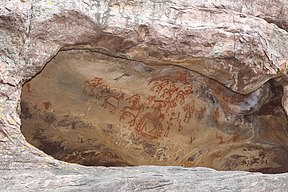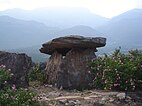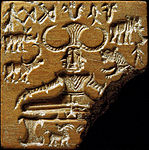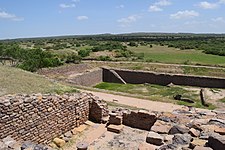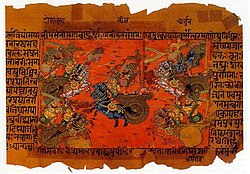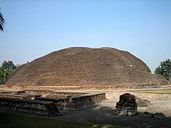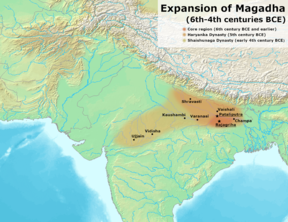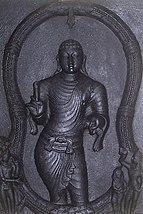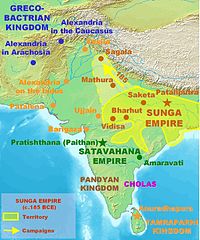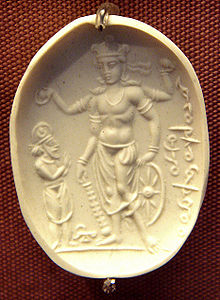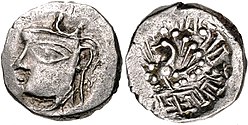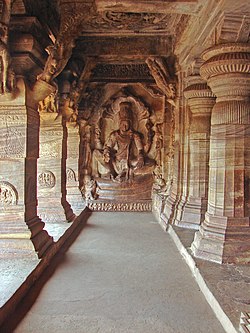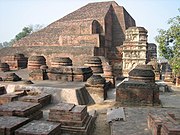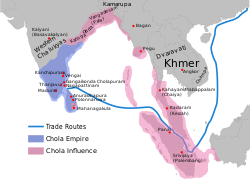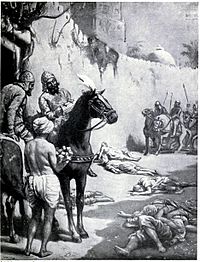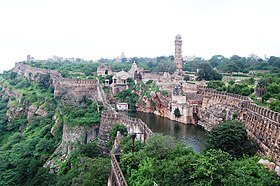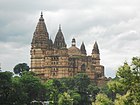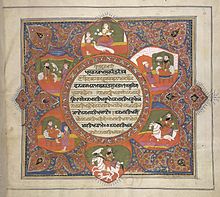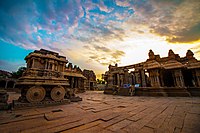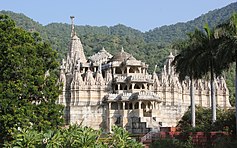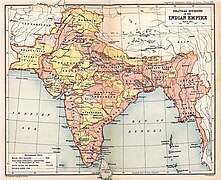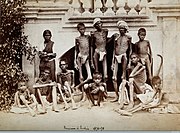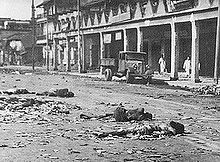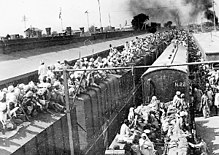History of India
Definition
The history of India includes the prehistoric settlements and societies in the Indian subcontinent; the advancement of civilisation from the Indus Valley Civilisation to the eventual blending of the Indo-Aryanculture to form the Vedic Civilisation; the rise of Hinduism, Jainism and Buddhism; the onset of a succession of powerful dynasties and empires for more than three millennia throughout various geographic areas of the Indian subcontinent, including the growth of Muslim dominions during the Medieval period intertwined with Hindu powers; the advent of European traders and privateers, resulting in the establishment of British India; and the subsequent independence movement that led to the Partition of India and the creation of the Republic of India.Archaeological evidence of anatomically modern humans in the Indian subcontinent is estimated to be as old as 73,000-55,000 years with some evidence of early hominids dating back to about 500,000 years ago. Considered a cradle of civilisation, the Indus Valley Civilisation, which spread and flourished in the north-western part of the Indian subcontinent from 3300 to 1300 BCE, was the first major civilisation in South Asia. A sophisticated and technologically advanced urban culture developed in the Mature Harappan period, from 2600 to 1900 BCE. This civilisation collapsed at the start of the second millennium BCE and was later followed by the Iron Age Vedic Civilisation. The era saw the composition of the Vedas, the seminal texts of Hinduism, coalesce into Janapadas (monarchical, state-level polities), and social stratification based on caste. The Later Vedic Civilisation extended over the Indo-Gangetic plain and much of the Indian subcontinent, as well as witnessed the rise of major polities known as the Mahajanapadas. In one of these kingdoms, Magadha, Gautama Buddha and Mahavira propagated their Śramaṇic philosophies during the fifth and sixth century BCE.
Most of the Indian subcontinent was conquered by the Maurya Empire during the 4th and 3rd centuries BCE. From the 3rd century BCE onwards Prakrit and Pali literature in the north and the Tamil Sangam literature in southern India started to flourish. Wootz steel originated in south India in the 3rd century BCE and was exported to foreign countries. During the Classical period, various parts of India were ruled by numerous dynasties for the next 1,500 years, among which the Gupta Empire stands out. This period, witnessing a Hindu religious and intellectual resurgence, is known as the classical or "Golden Age of India". During this period, aspects of Indian civilisation, administration, culture, and religion (Hinduism and Buddhism) spread to much of Asia, while kingdoms in southern India had maritime business links with the Middle East and the Mediterranean. Indian cultural influence spread over many parts of Southeast Asia which led to the establishment of Indianised kingdoms in Southeast Asia (Greater India).
The most significant event between the 7th and 11th century was the Tripartite struggle centred on Kannauj that lasted for more than two centuries between the Pala Empire, Rashtrakuta Empire, and Gurjara-Pratihara Empire. Southern India saw the rise of multiple imperial powers from the middle of the fifth century, most notable being the Chalukya, Chola, Pallava, Chera, Pandyan, and Western Chalukya Empires. The Chola dynasty conquered southern India and successfully invaded parts of Southeast Asia, Sri Lanka, Maldives and Bengal in the 11th century. The early medieval period Indian mathematicsinfluenced the development of mathematics and astronomy in the Arab world and the Hindu numerals were introduced.
Muslim rule started in parts of north India in the 13th century when the Delhi Sultanate was founded in 1206 CE by Central Asian Turks; though earlier Muslim conquests made limited inroads into modern Afghanistan and Pakistan as early as the 8th century. The Delhi Sultanate ruled the major part of northern India in the early 14th century, but declined in the late 14th century. This period also saw the emergence of several powerful Hindu states, notably Vijayanagara, Gajapati, Ahom, as well as Rajput states, such as Mewar. The 15th century saw the advent of Sikhism. The early modern period began in the 16th century, when the Mughals conquered most of the Indian subcontinent. The Mughals suffered a gradual decline in the early 18th century, which provided opportunities for the Marathas, Sikhs and Mysoreans to exercise control over large areas of the Indian subcontinent.
From the late 18th century to the mid-19th century, large areas of India were annexed by the British East India Company of the British Empire. Dissatisfaction with Company rule led to the Indian Rebellion of 1857, after which the British provinces of India were directly administered by the British Crown and witnessed a period of rapid development of infrastructure, economic decline and major famines. During the first half of the 20th century, a nationwide struggle for independence was launched with the leading party involved being the Indian National Congress which was later joined by other organisations. The Indian subcontinent gained independence from the United Kingdom in 1947, after the British provinces were partitioned into the dominions of India and Pakistan and the princely states all acceded to one of the new states.
Chronology of Indian history
James Mill (1773–1836), in his The History of British India (1817), distinguished three phases in the history of India, namely Hindu, Muslim and British civilisations. This periodisation has been influential, but has also been criticised for the misconceptions it gave rise to. Another influential periodisation is the division into "ancient, classical, medieval and modern periods", although this periodisation has also been criticised.Romila Thapar notes that the division into Hindu-Muslim-British periods of Indian history gives too much weight to "ruling dynasties and foreign invasions", neglecting the social-economic history which often showed a strong continuity. The division into Ancient-Medieval-Modern periods overlooks the fact that the Muslim conquests occurred gradually during which time many things came and went off, while the south was never completely conquered. According to Thapar, a periodisation could also be based on "significant social and economic changes", which are not strictly related to a change of ruling powers.
Prehistoric era (until c. 3300 BCE)
Stone Age
Archaeological evidence of anatomically modern humans in the Indian subcontinent is claimed to be as old as 78,000–74,000 years. Earlier hominids include Homo erectus from about 500,000 years ago. Isolated remains of Homo erectus in Hathnora in the Narmada Valley in central India indicate that India might have been inhabited since at least the Middle Pleistocene era, somewhere between 500,000 and 200,000 years ago. Tools crafted by proto-humans that have been dated back two million years have been discovered in the northwestern part of the Indian subcontinent. The ancient history of the region includes some of South Asia's oldest settlements and some of its major civilisations.
The earliest archaeological site in the Indian subcontinent is the Palaeolithic hominid site in the Soan River valley. Soanian sites are found in the Sivalik region across what are now India, Pakistan, and Nepal. The Mesolithic period in the Indian subcontinent was followed by the Neolithicperiod, when more extensive settlement of the Indian subcontinent occurred after the end of the last Ice Age approximately 12,000 years ago. The first confirmed semi-permanent settlements appeared 9,000 years ago in the Bhimbetka rock shelters in modern Madhya Pradesh, India. The Edakkal Caves are pictorial writings believed to date to at least 6,000 BCE, from the Neolithic man, indicating the presence of a prehistoric civilisation or settlement in Kerala. The Stone Age carvings of Edakkal are rare and are the only known examples from South India.
Traces of a Neolithic culture have been alleged to be submerged in the Gulf of Khambat in India, radiocarbon dated to 7500 BCE. Neolithic agricultural cultures sprang up in the Indus Valley region around 5000 BCE, in the lower Gangetic valley around 3000 BCE, represented by the Bhirrana findings (7570–6200 BCE) in Haryana, India, Lahuradewa findings (7000 BCE) in Uttar Pradesh, India, and Mehrgarh findings (7000–5000 BCE) in Balochistan, Pakistan; and later in Southern India, spreading southwards and also northwards into Malwa around 1800 BCE. The first urban civilisation of the region began with the Indus Valley Civilisation.
"First urbanisation" (c. 3300 – c. 1500 BCE)
Indus Valley Civilisation
| Indus Valley Civilisation |
|---|
|
The civilisation was primarily located in modern-day India (Gujarat, Haryana, Punjab, Rajasthan, Uttar Pradesh, Jammu and Kashmir provinces) and Pakistan (Sindh, Punjab, and Balochistan provinces). Historically part of Ancient India, it is one of the world's earliest urban civilisations, along with Mesopotamia and Ancient Egypt. Inhabitants of the ancient Indus river valley, the Harappans, developed new techniques in metallurgy and handicraft (carneol products, seal carving), and produced copper, bronze, lead, and tin.
The Mature Indus civilisation flourished from about 2600 to 1900 BCE, marking the beginning of urban civilisation on the Indian subcontinent. The civilisation included urban centres such as Dholavira, Kalibangan, Ropar, Rakhigarhi, and Lothal in modern-day India, as well as Harappa, Ganeriwala, and Mohenjo-daro in modern-day Pakistan. The civilisation is noted for its cities built of brick, roadside drainage system, and multi-storeyed houses and is thought to have had some kind of municipal organisation. Total of 1,022 cities and settlements had been found, mainly in the general region of the Indus and Ghaggar-Hakra Rivers, and their tributaries; of which 406 sites are in Pakistan and 616 sites in India, of these 96 have been excavated.
During the late period of this civilisation, signs of a gradual decline began to emerge, and by around 1700 BCE, most of the cities were abandoned. However, the Indus Valley Civilisation did not disappear suddenly, and some elements of the Indus Civilisation may have survived, especially in the smaller villages and isolated farms. According to historian Upinder Singh, "the general picture presented by the late Harappan phase is one of a breakdown of urban networks and an expansion of rural ones." The Indian Copper Hoard Culture is attributed to this time, associated in the Doab region with the Ochre Coloured Pottery.
Dravidian origins
Linguists hypothesized that Dravidian-speaking people were spread throughout the Indian subcontinent before a series of Indo-Aryan migrations. In this view, the early Indus Valley civilisation is often identified as having been Dravidian. Cultural and linguistic similarities have been cited by researchers Henry Heras, Kamil Zvelebil, Asko Parpola and Iravatham Mahadevan as being strong evidence for a proto-Dravidian origin of the ancient Indus Valley civilisation. Linguist Asko Parpola writes that the Indus script and Harappan language "most likely to have belonged to the Dravidian family".Parpola led a Finnish team in investigating the inscriptions using computer analysis. Based on a proto-Dravidian assumption, they proposed readings of many signs, some agreeing with the suggested readings of Heras and Knorozov (such as equating the "fish" sign with the Dravidian word for fish "min") but disagreeing on several other readings. A comprehensive description of Parpola's work until 1994 is given in his book Deciphering the Indus Script. The discovery in Tamil Nadu of a late Neolithic (early 2nd millennium BCE, i.e. post-dating Harappan decline) stone celt allegedly marked with Indus signs has been considered by some to be significant for the Dravidian identification. While, Yuri Knorozov surmised that the symbols represent a logosyllabic script and suggested, based on computer analysis, an underlying agglutinative Dravidian language as the most likely candidate for the underlying language. Knorozov's suggestion was preceded by the work of Henry Heras, who suggested several readings of signs based on a proto-Dravidian assumption. While some scholars like J. Bloch and M. Witzel believe that the Indo-Aryans moved into an already Dravidian speaking area after the oldest parts of the Rig Veda were already composed. The Brahui population of Balochistan has been taken by some as the linguistic equivalent of a relict population, perhaps indicating that Dravidian languages were formerly much more widespread and were supplanted by the incoming Indo-Aryan languages.
Vedic period (c. 1500 – c. 600 BCE)
The Vedic period is named after the Indo-Aryan culture of north-west India, although other parts of India had a distinct cultural identity during this period. The Vedic culture is described in the texts of Vedas, still sacred to Hindus, which were orally composed in Vedic Sanskrit. The Vedas are some of the oldest extant texts in India. The Vedic period, lasting from about 1500 to 500 BCE, contributed the foundations of several cultural aspects of the Indian subcontinent. In terms of culture, many regions of the Indian subcontinent transitioned from the Chalcolithicto the Iron Age in this period.Vedic society
| Vedic society |
|---|
|
Early Vedic society is described in the Rigveda, the oldest Vedic text, believed to have been compiled during 2nd millennium BCE, in the northwestern region of the Indian subcontinent. At this time, Aryan society consisted of largely tribal and pastoral groups, distinct from the Harappan urbanisation which had been abandoned. The early Indo-Aryan presence probably corresponds, in part, to the Ochre Coloured Pottery culture in archaeological contexts.
At the end of the Rigvedic period, the Aryan society began to expand from the northwestern region of the Indian subcontinent, into the western Ganges plain. It became increasingly agricultural and was socially organised around the hierarchy of the four varnas, or social classes. This social structure was characterised both by syncretising with the native cultures of northern India, but also eventually by the excluding of some indigenous peoples by labeling their occupations impure. During this period, many of the previous small tribal units and chiefdoms began to coalesce into Janapadas (monarchical, state-level polities).
In the 14th century BCE, the Battle of the Ten Kings, between the Puru Vedic Aryan tribal kingdoms of the Bharatas, allied with other tribes of the Northwest India, guided by the royal sage Vishvamitra, and the Trtsu-Bharata (Puru) king Sudas, who defeats other Vedic tribes—leading to the emergence of the Kuru Kingdom, first state level society during the Vedic period.
Sanskritisation
Since Vedic times, "people from many strata of society throughout the Indian subcontinent tended to adapt their religious and social life to Brahmanic norms", a process sometimes called Sanskritisation. It is reflected in the tendency to identify local deities with the gods of the Sanskrit texts.
Janapadas
The Iron Age in the Indian subcontinent from about 1200 BCE to the 6th century BCE is defined by the rise of Janapadas, which are realms, republics and kingdoms — notably the Iron Age Kingdoms of Kuru, Panchala, Kosala, Videha.
The Kuru kingdom was the first state-level society of the Vedic period, corresponding to the beginning of the Iron Age in northwestern India, around 1200 – 800 BCE, as well as with the composition of the Atharvaveda (the first Indian text to mention iron, as śyāma ayas, literally "black metal"). The Kuru state organised the Vedic hymns into collections, and developed the orthodox srauta ritual to uphold the social order. Two key figures of the Kuru state were king Parikshit and his successor Janamejaya, transforming this realm into the dominant political and cultural power of northern Iron Age India. When the Kuru kingdom declined, the centre of Vedic culture shifted to their eastern neighbours, the Panchala kingdom. The archaeological Painted Grey Ware culture, which flourished in the Haryana and western Uttar Pradesh regions of northern India from about 1100 to 600 BCE, is believed to correspond to the Kuru and Panchala kingdoms.
During the Late Vedic Period, the kingdom of Videha emerged as a new centre of Vedic culture, situated even farther to the East (in what is today Nepal and Bihar state in India); reaching its prominence under the king Janaka, whose court provided patronage for Brahmin sages and philosophers such as Yajnavalkya, Aruni, and Gargi Vachaknavi. The later part of this period corresponds with a consolidation of increasingly large states and kingdoms, called mahajanapadas, all across Northern India.
Sanskrit Epics
In addition to the Vedas, the principal texts of Hinduism, the core themes of the Sanskrit epics Ramayana and Mahabharata are said to have their ultimate origins during this period. The Mahabharata remains, today, the longest single poem in the world. Historians formerly postulated an "epic age" as the milieu of these two epic poems, but now recognise that the texts (which are both familiar with each other) went through multiple stages of development over centuries. For instance, the Mahabharata may have been based on a small-scale conflict (possibly about 1000 BCE) which was eventually "transformed into a gigantic epic war by bards and poets". There is no conclusive proof from archaeology as to whether the specific events of the Mahabharata have any historical basis. The existing texts of these epics are believed to belong to the post-Vedic age, between c. 400 BCE and 400 CE.Some even attempted to date the events using methods of archaeo-astronomy which have produced, depending on which passages are chosen and how they are interpreted, estimated dates ranging up to mid 2nd millennium BCE.
"Second urbanisation" (c. 600 – c. 200 BCE)
During the time between 800 and 200 BCE the Śramaṇa movement formed, from which originated Jainism and Buddhism. In the same period, the first Upanishads were written. After 500 BCE, the so-called "Second urbanisation" started, with new urban settlements arising at the Ganges plain, especially the Central Ganges plain. The foundations for the Second Urbanisation were laid prior to 600 BCE, in the Painted Grey Ware culture of the Ghaggar-Hakra and Upper Ganges Plain; although most PGW sites were small farming villages, "several dozen" PGW sites eventually emerged as relatively large settlements that can be characterized as towns, the largest of which were fortified by ditches or moats and embankments made of piled earth with wooden palisades, albeit smaller and simpler than the elaborately fortified large cities which grew after 600 BCE in the Northern Black Polished Ware culture. The Central Ganges Plain, where Magadha gained prominence, forming the base of the Mauryan Empire, was a distinct cultural area, with new states arising after 500 BCE during the so-called "Second urbanisation". It was influenced by the Vedic culture, but differed markedly from the Kuru-Panchala region. It "was the area of the earliest known cultivation of rice in South Asia and by 1800 BCE was the location of an advanced Neolithic population associated with the sites of Chirand and Chechar". In this region, the Śramaṇic movements flourished, and Jainism and Buddhism originated.
Upanishads and Śramaṇa movements
Around 800 BCE to 400 BCE witnessed the composition of the earliest Upanishads. Upanishads form the theoretical basis of classical Hinduism and are known as Vedanta (conclusion of the Vedas). The older Upanishads launched attacks of increasing intensity on the ritual. Anyone who worships a divinity other than the Self is called a domestic animal of the gods in the Brihadaranyaka Upanishad. The Mundaka launches the most scathing attack on the ritual by comparing those who value sacrifice with an unsafe boat that is endlessly overtaken by old age and death.
Increasing urbanisation of India in 7th and 6th centuries BCE led to the rise of new ascetic or Śramaṇa movements which challenged the orthodoxy of rituals. Mahavira (c. 549–477 BCE), proponent of Jainism, and Gautama Buddha (c. 563–483 BCE), founder of Buddhismwere the most prominent icons of this movement. Śramaṇa gave rise to the concept of the cycle of birth and death, the concept of samsara, and the concept of liberation. Buddha found a Middle Way that ameliorated the extreme asceticism found in the Śramaṇa religions.
Around the same time, Mahavira (the 24th Tirthankara in Jainism) propagated a theology that was to later become Jainism. However, Jain orthodoxy believes the teachings of the Tirthankaras predates all known time and scholars believe Parshvanatha (c. 872 – c. 772 BCE), accorded status as the 23rd Tirthankara, was a historical figure. Rishabhanatha was the 1st Tirthankara. The Vedas are believed to have documented a few Tirthankaras and an ascetic order similar to the Śramaṇa movement.
Mahajanapadas
From c. 600 BCE to c. 300 BCE, withnessed the rise of Mahajanapadas, which were sixteen powerful and vast kingdoms and oligarchicrepublics. These Mahajanapadas evolved and flourished in a belt stretching from Gandhara in the northwest to Bengal in the eastern part of the Indian subcontinent and included parts of the trans-Vindhyan region. Ancient Buddhist texts, like the Anguttara Nikaya, make frequent reference to these sixteen great kingdoms and republics—Anga, Assaka, Avanti, Chedi, Gandhara, Kashi, Kamboja, Kosala, Kuru, Magadha, Malla, Matsya (or Machcha), Panchala, Surasena, Vriji, and Vatsa—this period saw the second major rise of urbanism in India after the Indus Valley Civilisation.
Many smaller clans mentioned within early literature seem to have been present across the rest of the Indian subcontinent. Some of these kings were hereditary; other states elected their rulers. Early "republics" or Gaṇa sangha, such as the Vajji (or Vriji) confederation, centered in the city of Vaishali, existed as early as the 6th century BCE and persisted in some areas until the 4th century CE. The most famous clan amongst the ruling confederate clans of the Vajji Mahajanapada were the Licchavis.
This period corresponds in an archaeological context to the Northern Black Polished Ware culture. Especially focused in the Central Ganges plain but also spreading across vast areas of the northern and central Indian subcontinent, this culture is characterized by the emergence of large cities with massive fortifications, significant population growth, increased social stratification, wide-ranging trade networks, construction of public architecture and water channels, specialized craft industries (e.g., ivory and carnelian carving), a system of weights, punch-marked coins, and the introduction of writing in the form of Brahmi and Kharosthi scripts. The language of the gentry at that time was Sanskrit, while the languages of the general population of northern India are referred to as Prakrits.
Many of the sixteen kingdoms had coalesced into four major ones by 500/400 BCE, by the time of Gautama Buddha. These four were Vatsa, Avanti, Kosala, and Magadha. The life of Gautama Buddha was mainly associated with these four kingdoms.
Magadha dynasties
Magadha formed one of the sixteen Mahā-Janapadas (Sanskrit: "Great Countries") or kingdoms in ancient India. The core of the kingdom was the area of Bihar south of the Ganges; its first capital was Rajagriha (modern Rajgir) then Pataliputra (modern Patna). Magadha expanded to include most of Bihar and Bengal with the conquest of Licchavi and Anga respectively, followed by much of eastern Uttar Pradesh and Orissa. The ancient kingdom of Magadha is heavily mentioned in Jain and Buddhist texts. It is also mentioned in the Ramayana, Mahabharata and Puranas. The earliest reference to the Magadha people occurs in the Atharva-Veda where they are found listed along with the Angas, Gandharis, and Mujavats. Magadha played an important role in the development of Jainism and Buddhism, and two of India's greatest empires, the Maurya Empire and Gupta Empire, originated from Magadha. These empires saw advancements in ancient India's science, mathematics, astronomy, religion, and philosophy and were considered the Indian "Golden Age". The Magadha kingdom included republican communities such as the community of Rajakumara. Villages had their own assemblies under their local chiefs called Gramakas. Their administrations were divided into executive, judicial, and military functions.
The Hindu epic Mahabharata calls Brihadratha the first ruler of Magadha. Early sources, from the Buddhist Pāli Canon, the Jain Agamas and the Hindu Puranas, mentions Magadha being ruled by the Haryanka dynasty for some 200 years, c. 600 BCE – 413 BCE. King Bimbisara of the Haryanka dynasty led an active and expansive policy, conquering Anga in what is now eastern Bihar and West Bengal. King Bimbisara was overthrown and killed by his son, Prince Ajatashatru, who continued the expansionist policy of Magadha. During this period, Gautama Buddha, the founder of Buddhism, lived much of his life in Magadha kingdom. He attained enlightenment in Bodh Gaya, gave his first sermon in Sarnath and the first Buddhist council was held in Rajgriha. The Haryanka dynasty was overthrown by the Shishunaga dynasty. The last Shishunaga ruler, Kalasoka, was assassinated by Mahapadma Nanda in 345 BCE, the first of the so-called Nine Nandas, Mahapadma and his eight sons. The Nanda Empire extended across much of northern India.
Persians and Greeks in northwest South Asia
In 530 BCE Cyrus the Great, King of the Persian Achaemenid Empire crossed the Hindu-Kush mountains to seek tribute from the tribes of Kamboja, Gandhara and the trans-India region (modern Afghanistan and Pakistan). By 520 BCE, during the reign of Darius I of Persia, much of the north-western Indian subcontinent (present-day eastern Afghanistan and Pakistan) came under the rule of the Persian Achaemenid Empire, as part of the far easternmost territories. The area remained under Persian control for two centuries. During this time India supplied mercenaries to the Persian army then fighting in Greece. Under Persian rule the famous city of Takshashila became a centre where both Vedic and Iranian learning were mingled. Persian ascendency in North-western South Asia ended with Alexander the Great's conquest of Persia in 327 BCE.
By 326 BCE, Alexander the Great had conquered Asia Minor and the Achaemenid Empire and had reached the northwest frontiers of the Indian subcontinent. There he defeated King Porus in the Battle of the Hydaspes (near modern-day Jhelum, Pakistan) and conquered much of the Punjab. Alexander's march east put him in confrontation with the Nanda Empire of Magadha and the Gangaridai of Bengal. His army, exhausted and frightened by the prospect of facing larger Indian armies at the Ganges River, mutinied at the Hyphasis (modern Beas River) and refused to march further East. Alexander, after the meeting with his officer, Coenus, and after learning about the might of the Nanda Empire, was convinced that it was better to return.
The Persian and Greek invasions had repercussions in the north-western regions of the Indian subcontinent. The region of Gandhara, or present-day eastern Afghanistan and north-west Pakistan, became a melting pot of Indian, Persian, Central Asian, and Greek cultures and gave rise to a hybrid culture, Greco-Buddhism, which lasted until the 5th century CE and influenced the artistic development of Mahayana Buddhism.
Maurya Empire
The Maurya Empire (322–185 BCE) was the first empire to unify India into one state, and was the largest on the Indian subcontinent. At its greatest extent, the Mauryan Empire stretched to the north up to the natural boundaries of the Himalayas and to the east into what is now Assam. To the west, it reached beyond modern Pakistan, to the Hindu Kush mountains in what is now Afghanistan. The empire was established by Chandragupta Maurya assisted by Chanakya (Kautilya) in Magadha (in modern Bihar) when he overthrew the Nanda Dynasty. Chandragupta's son Bindusara succeeded to the throne around 297 BCE. By the time he died in c. 272 BCE, a large part of the Indian subcontinent was under Mauryan suzerainty. However, the region of Kalinga (around modern day Odisha) remained outside Mauryan control, perhaps interfering with their trade with the south.
Bindusara was succeeded by Ashoka, whose reign lasted for around 37 years until his death in about 232 BCE. His campaign against the Kalingans in about 260 BCE, though successful, lead to immense loss of life and misery. This filled Ashoka with remorse and lead him to shun violence, and subsequently to embrace Buddhism. The empire began to decline after his death and the last Mauryan ruler, Brihadratha, was assassinated by Pushyamitra Shunga to establish the Shunga Empire.
The Arthashastra and the Edicts of Ashoka are the primary written records of the Mauryan times. Archaeologically, this period falls into the era of Northern Black Polished Ware (NBPW). The Mauryan Empire was based on a modern and efficient economy and society. However, the sale of merchandise was closely regulated by the government. Although there was no banking in the Mauryan society, usury was customary. A significant amount of written records on slavery are found, suggesting a prevalence thereof. During this period, a high quality steel called Wootz steelwas developed in south India and was later exported to China and Arabia.
Sangam Period
During the Sangam period Tamil literature flourished from the 3rd century BCE to the 4th century CE. During this period, three Tamil dynasties, collectively known as the Three Crowned Kings of Tamilakam: Chera dynasty, Chola dynasty and the Pandyan dynasty ruled parts of southern India.
The Sangam literature deals with the history, politics, wars, and culture of the Tamil people of this period. The scholars of the Sangam period rose from among the common people who sought the patronage of the Tamil Kings, but who mainly wrote about the common people and their concerns. Unlike Sanskrit writers who were mostly Brahmins, Sangam writers came from diverse classes and social backgrounds and were mostly non-Brahmins. They belonged to different faiths and professions like farmers, artisans, merchants, monks, priests and even princes and quite a few of them were even women.
Around c. 300 BCE – c. 200 CE., Pathupattu, an anthology of ten mid-length books collection, which is considered part of Sangam Literature, were composed; the composition of eight anthologies of poetic works Ettuthogai as well as the composition of eighteen minor poetic works Patiṉeṇkīḻkaṇakku; while Tolkāppiyam, the earliest grammarian work in the Tamil language was developed. Also, during Sangam period, around 1st-century CE., two of the Five Great Epics of Tamil Literature were composed. Ilango Adigal composed Silappatikaram, which is a non-religious work, that revolves around Kannagi, who having lost her husband to a miscarriage of justice at the court of the Pandyan dynasty, wreaks her revenge on his kingdom, and Manimekalai, composed by Sīthalai Sāttanār, is a sequel to Silappatikaram, and tells the story of the daughter of Kovalan and Madhavi, who became a Buddhist Bikkuni.
Classical to early medieval periods (c. 200 BCE – c. 1200 CE)
The time between the Maurya Empire in the 3rd century BCE and the end of the Gupta Empire in the 6th century CE is referred to as the "Classical" period of India. It can be divided in various sub-periods, depending on the chosen periodisation. Classical period begins after the decline of the Maurya Empire, and the corresponding rise of the Shunga dynasty and Satavahana dynasty. The Gupta Empire (4th–6th century) is regarded as the "Golden Age" of Hinduism, although a host of kingdoms ruled over India in these centuries. Also, the Sangam literature flourished from the 3rd century BCE to the 3rd century CE in southern India. During this period, India's economy is estimated to have been the largest in the world, having between one-third and one-quarter of the world's wealth, from 1 CE to 1000 CE.
Early classical period (c. 200 BCE – c. 320 CE)
Shunga Empire
| Shunga Empire |
|---|
|
Pushyamitra Shunga ruled for 36 years and was succeeded by his son Agnimitra. There were ten Shunga rulers. However, after the death of Agnimitra, the empire rapidly disintegrated;inscriptions and coins indicate that much of northern and central India consisted of small kingdoms and city-states that were independent of any Shunga hegemony. The empire is noted for its numerous wars with both foreign and indigenous powers. They fought battles with the Mahameghavahana dynasty of Kalinga, Satavahana dynasty of Deccan, the Indo-Greeks, and possibly the Panchalas and Mitras of Mathura.
Art, education, philosophy, and other forms of learning flowered during this period including small terracotta images, larger stone sculptures, and architectural monuments such as the Stupa at Bharhut, and the renowned Great Stupa at Sanchi. The Shunga rulers helped to establish the tradition of royal sponsorship of learning and art. The script used by the empire was a variant of Brahmi and was used to write the Sanskrit language. The Shunga Empire played an imperative role in patronising Indian culture at a time when some of the most important developments in Hindu thought were taking place. This helped the empire flourish and gain power.
Satavahana Empire
| Satavahana Empire |
|---|
|
The Sātavāhanas are known for their patronage of Hinduism and Buddhism, which resulted in Buddhist monuments from Ellora (a UNESCO World Heritage Site) to Amaravati. They were one of the first Indian states to issue coins struck with their rulers embossed. They formed a cultural bridge and played a vital role in trade as well as the transfer of ideas and culture to and from the Indo-Gangetic Plain to the southern tip of India.
They had to compete with the Shunga Empire and then the Kanva dynasty of Magadha to establish their rule. Later, they played a crucial role to protect large part of India against foreign invaders like the Sakas, Yavanas and Pahlavas. In particular, their struggles with the Western Kshatrapas went on for a long time. The notable rulers of the Satavahana Dynasty Gautamiputra Satakarni and Sri Yajna Sātakarni were able to defeat the foreign invaders like the Western Kshatrapas and to stop their expansion. In the 3rd century CE the empire was split into smaller states.
Northwestern kingdoms and hybrid cultures
The Northwestern kingdoms and hybrid cultures of the Indian subcontinent included the Indo-Greeks, the Indo-Scythians, the Indo-Parthians, and the Indo-Sassinids.
- The Indo-Greeks were a hybrid culture straddled across multiple Indo-Greek kingdoms. Lasting for almost two centuries, the kingdoms were ruled by a succession of more than 30 Indo-Greek kings, who were often in conflict with each other. The Indo-Greeks reached their height under Menander I (reigned 155–130 BCE), who drove the Greco-Bactrians out of Gandhara and beyond the Hindu Kush, becoming a king shortly after his victory. His territories covered Panjshir and Kapisa in modern Afghanistan and extended to the Punjab region in the Indian subcontinent, with many tributaries to the south and east. Menander I embraced the Buddhist faith, as described in the classical Buddhist text Milinda Panha. After his conversion, he became noted for being a leading patron of Buddhism.
- The Indo-Scythians were descended from the Sakas (Scythians) who migrated from southern Siberia to Pakistan and Arachosia to India from the middle of the 2nd century BCE to the 1st century BCE. They displaced the Indo-Greeks and ruled a kingdom that stretched from Gandhara to Mathura. The power of the Saka rulers started to decline in the 2nd century CE after the Scythian Western Satraps were defeated by the south Indian Emperor Gautamiputra Satakarni of the Satavahana dynasty. Later the Saka kingdom was completely destroyed by Chandragupta II of the Gupta Empire from eastern India in the 4th century.
- The Indo-Parthians were ruled by the Gondopharid dynasty, named after its eponymous first ruler Gondophares. They ruled parts of present-day Afghanistan, Pakistan, and northwestern India, during or slightly before the 1st century CE. For most of their history, the leading Gondopharid kings held Taxila (in the present Punjab province of Pakistan) as their residence and ruled from there, but during their last few years of existence the capital shifted between Kabul and Peshawar. These kings have traditionally been referred to as Indo-Parthians, as their coinage was often inspired by the Arsacid dynasty, but they probably belonged to a wider groups of Iranic tribes who lived east of Parthia proper, and there is no evidence that all the kings who assumed the title Gondophares, which means "Holder of Glory", were even related. The Indo-Parthians are noted for the construction of the Buddhist monastery Takht-i-Bahi.
- The Indo-Sassanids have their origin with the Sassanid Empire of Persia, who was contemporaneous with the Gupta Empire, expanded into the region of present-day Balochistan, Pakistan, where the mingling of Indian culture and the culture of Iran gave birth to a hybrid culture under the Indo-Sassanids.
Trade and travels to India
| Trade and Travels to India |
|---|
|
The spice trade in Kerala attracted traders from all over the Old World to India. Early writings and Stone Age carvings of Neolithic age obtained indicates that India's Southwest coastal port Muziris, in Kerala, had established itself as a major spice trade centre from as early as 3,000 BCE, according to Sumerian records. Jewish traders from Judea arrived in Kochi, Kerala, India as early as 562 BCE, and more Jewish traders came as exiles in 70 CE after the destruction of the Second Temple. Kerala was referred to as the land of spices or as the "Spice Garden of India". It was the place traders and exporters wanted to reach, including Christopher Colombus, Vasco da Gama, and others.
- Thomas the Apostle sailed to India around the 1st century CE. He landed in Muziris in Kerala, India and established Yezh (Seven) ara (half) palligal (churches) or Seven and a Half Churches.
- Buddhism entered China through the Silk Road transmission of Buddhism in the 1st or 2nd century CE. The interaction of cultures resulted in several Chinese travellers and monks to enter India. Most notable were Faxian, Yijing, Song Yunand Xuanzang. These travellers wrote detailed accounts of the Indian Subcontinent, which includes the political and social aspects of the region.
- Hindu and Buddhist religious establishments of Southeast Asia came to be associated with the economic activity and commerce as patrons entrust large funds which would later be used to benefit the local economy by estate management, craftsmanship, promotion of trading activities. Buddhism in particular, travelled alongside the maritime trade, promoting coinage, art, and literacy. Indian merchants involved in spice trade took Indian cuisine to Southeast Asia, where spice mixtures and curries became popular with the native inhabitants.
- The Greco-Roman world followed by trading along the incense route and the Roman-India routes. During the 2nd century BCE Greek and Indian ships met to trade at Arabian ports such as Aden (called Eudaemon by the Greeks).According to Poseidonius, later reported in Strabo's Geography, the monsoon wind system of the Indian Ocean was first sailed by Eudoxus of Cyzicus in 118 or 116 BCE. Poseidonius said a shipwrecked sailor from India had been rescued in the Red Sea and taken to Ptolemy VIII in Alexandria. Strabo, whose Geography is the main surviving source of the story, was skeptical about its truth. Modern scholarship tends to consider it relatively credible. Another Greek navigator, Hippalus, is sometimes credited with discovering the monsoon wind route to India. He is sometimes conjectured to have been part of Eudoxus's expeditions. During the first millennium, the sea routes to India were controlled by the Indians and Ethiopians that became the maritime trading power of the Red Sea.
Kushan Empire
| Kushan Empire |
|---|
|
Emperor Kanishka was a great patron of Buddhism; however, as Kushans expanded southward, the deities of their later coinage came to reflect its new Hindu majority. They played an important role in the establishment of Buddhism in India and its spread to Central Asia and China.
Historian Vincent Smith said about Kanishka:
The empire linked the Indian Ocean maritime trade with the commerce of the Silk Road through the Indus valley, encouraging long-distance trade, particularly between China and Rome. The Kushans brought new trends to the budding and blossoming Gandhara art and Mathura art, which reached its peak during Kushan rule.
H.G. Rowlinson commented:
By the 3rd century, their empire in India was disintegrating and their last known great emperor was Vasudeva I.
Classical period (c. 320 – c. 650 CE)
Gupta Empire – Golden Age
| Gupta Empire – Golden Age |
|---|
|
The high points of this cultural creativity are magnificent architecture, sculpture, and painting. The Gupta period produced scholars such as Kalidasa, Aryabhata, Varahamihira, Vishnu Sharma, and Vatsyayana who made great advancements in many academic fields. The Gupta period marked a watershed of Indian culture: the Guptas performed Vedic sacrifices to legitimise their rule, but they also patronised Buddhism, which continued to provide an alternative to Brahmanical orthodoxy. The military exploits of the first three rulers – Chandragupta I, Samudragupta, and Chandragupta II – brought much of India under their leadership. Science and political administration reached new heights during the Gupta era. Strong trade ties also made the region an important cultural centre and established it as a base that would influence nearby kingdoms and regions in Burma, Sri Lanka, Maritime Southeast Asia, and Indochina.
The latter Guptas successfully resisted the northwestern kingdoms until the arrival of the Alchon Huns, who established themselves in Afghanistan by the first half of the 5th century, with their capital at Bamiyan. However, much of the Deccan and southern India were largely unaffected by these events in the north.
Vakataka Empire
The Vākāṭaka Empire originated from the Deccan in the mid-third century CE. Their state is believed to have extended from the southern edges of Malwa and Gujarat in the north to the Tungabhadra River in the south as well as from the Arabian Sea in the western to the edges of Chhattisgarh in the east. They were the most important successors of the Satavahanas in the Deccan, contemporaneous with the Guptas in northern India and succeeded by the Vishnukundina dynasty.
The Vakatakas are noted for having been patrons of the arts, architecture and literature. They led public works and their monuments are a visible legacy. The rock-cut Buddhist viharas and chaityas of Ajanta Caves (a UNESCO World Heritage Site) were built under the patronage of Vakataka emperor, Harishena.
Kamarupa Kingdom
Samudragupta's 4th-century Allahabad pillar inscription mentions Kamarupa (Western Assam) and Davaka (Central Assam) as frontier kingdoms of the Gupta Empire. Davaka was later absorbed by Kamarupa, which grew into a large kingdom that spanned from Karatoya river to near present Sadiya and covered the entire Brahmaputra valley, North Bengal, parts of Bangladesh and, at times Purnea and parts of West Bengal.
Ruled by three dynasties Varmanas (c. 350–650 CE), Mlechchha dynasty (c. 655–900 CE) and Kamarupa-Palas (c. 900–1100 CE), from their capitals in present-day Guwahati(Pragjyotishpura), Tezpur (Haruppeswara) and North Gauhati (Durjaya) respectively. All three dynasties claimed their descent from Narakasura, an immigrant from Aryavarta. In the reign of the Varman king, Bhaskar Varman (c. 600–650 CE), the Chinese traveller Xuanzang visited the region and recorded his travels. Later, after weakening and disintegration (after the Kamarupa-Palas), the Kamarupa tradition was somewhat extended till c. 1255 CE by the Lunar I (c. 1120 – 1185 CE) and Lunar II (c. 1155 – 1255 CE) dynasties. The Kamarupa kingdom came to an end in the middle of the 13th century when the Khen dynasty under Sandhya of Kamarupanagara (North Guwahati), moved his capital to Kamatapur (North Bengal) after the invasion of Muslim Turks, and established the Kamata kingdom.
Pallava Empire
The Pallavas, during the 4th to 9th centuries were, alongside the Guptas of the North, great patronisers of Sanskrit development in the South of the Indian subcontinent. The Pallava reign saw the first Sanskrit inscriptions in a script called Grantha. Early Pallavas had different connexions to Southeast Asian countries. The Pallavas used Dravidian architecture to build some very important Hindu temples and academies in Mamallapuram, Kanchipuramand other places; their rule saw the rise of great poets. The practice of dedicating temples to different deities came into vogue followed by fine artistic temple architecture and sculpture style of Vastu Shastra.
Pallavas reached the height of power during the reign of Mahendravarman I (571 – 630 CE) and Narasimhavarman I (630 – 668 CE) and dominated the Telugu and northern parts of the Tamil region for about six hundred years until the end of the 9th century.
Kadamba Empire
Kadambas originated from Karnataka, was founded by Mayurasharma in 345 CE which at later times showed the potential of developing into imperial proportions, an indication to which is provided by the titles and epithets assumed by its rulers. King Mayurasharma defeated the armies of Pallavas of Kanchi possibly with help of some native tribes. The Kadamba fame reached its peak during the rule of Kakusthavarma, a notable ruler with whom even the kings of Gupta Dynasty of northern India cultivated marital alliances. The Kadambas were contemporaries of the Western Ganga Dynasty and together they formed the earliest native kingdoms to rule the land with absolute autonomy. The dynasty later continued to rule as a feudatory of larger Kannada empires, the Chalukya and the Rashtrakuta empires, for over five hundred years during which time they branched into minor dynasties known as the Kadambas of Goa, Kadambas of Halasi and Kadambas of Hangal.
Alchon Huns
| Alchon Huns |
|---|
|
Empire of Harsha
Harsha ruled northern India from 606 to 647 CE. He was the son of Prabhakarvardhana and the younger brother of Rajyavardhana, who were members of the Pushyabhuti dynasty and ruled Thanesar, in present-day Haryana.
After the downfall of the prior Gupta Empire in the middle of the 6th century, North India reverted to smaller republics and monarchical states. The power vacuum resulted in the rise of the Vardhanas of Thanesar, who began uniting the republics and monarchies from the Punjab to central India. After the death of Harsha's father and brother, representatives of the empire crowned Harsha emperor at an assembly in April 606 CE, giving him the title of Maharaja when he was merely 16 years old. At the height of his power, his Empire covered much of North and Northwestern India, extended East till Kamarupa, and South until Narmada River; and eventually made Kannauj (in present Uttar Pradesh state) his capital, and ruled till 647 CE.
The peace and prosperity that prevailed made his court a centre of cosmopolitanism, attracting scholars, artists and religious visitors from far and wide. During this time, Harsha converted to Buddhism from Suryaworship. The Chinese traveller Xuanzang visited the court of Harsha and wrote a very favourable account of him, praising his justice and generosity. His biography Harshacharita ("Deeds of Harsha") written by Sanskrit poet Banabhatta, describes his association with Thanesar, besides mentioning the defence wall, a moat and the palace with a two-storied Dhavalagriha (White Mansion).
Early medieval period (c. 650 – 1200 CE)
Early medieval India began after the end of the Gupta Empire in the 6th century CE. This period also covers the "Late Classical Age" of Hinduism,which began after the end of the Gupta Empire, and the collapse of the Empire of Harsha in the 7th century CE; the beginning of Imperial Kannauj, leading to the Tripartite struggle; and ended in the 13th century with the rise of the Delhi Sultanate in Northern India and the end of the Later Cholas with the death of Rajendra Chola III in 1279 in Southern India; however some aspects of the Classical period continued until the fall of the Vijayanagara Empire in the south around the 17th century.
From the fifth century to the thirteenth, Śrauta sacrifices declined, and initiatory traditions of Buddhism, Jainism or more commonly Shaivism, Vaishnavismand Shaktism expanded in royal courts. This period produced some of India's finest art, considered the epitome of classical development, and the development of the main spiritual and philosophical systems which continued to be in Hinduism, Buddhism and Jainism.
North-Western Indian Buddhism weakened in the 6th century after the Alchon Huns invasion, who followed their own religions at the beginning such as Tengri, but later Indian religions. Muhammad bin Qasim's invasion of Sindh (modern Pakistan) in 711 CE witnessed further decline of Buddhism. The Chach Nama records many instances of conversion of stupas to mosques such as at Nerun.
In the 7th century CE, Kumārila Bhaṭṭa formulated his school of Mimamsa philosophy and defended the position on Vedic rituals against Buddhist attacks. Scholars note Bhaṭṭa's contribution to the decline of Buddhism in India. His dialectical success against the Buddhists is confirmed by Buddhist historian Tathagata, who reports that Kumārila defeated disciples of Buddhapalkita, Bhavya, Dharmadasa, Dignaga and others.
In the 8th century, Adi Shankara travelled across the Indian subcontinent to propagate and spread the doctrine of Advaita Vedanta, which he consolidated; and is credited with unifying the main characteristics of the current thoughts in Hinduism. He was a critic of both Buddhism and Minamsa school of Hinduism; and founded mathas (monasteries), in the four corners of the Indian subcontinent for the spread and development of Advaita Vedanta.
Ronald Inden writes that by the 8th century CE symbols of Hindu gods "replaced the Buddha at the imperial centre and pinnacle of the cosmo-political system, the image or symbol of the Hindu god comes to be housed in a monumental temple and given increasingly elaborate imperial-style puja worship".Although Buddhism did not disappear from India for several centuries after the eighth, royal proclivities for the cults of Vishnu and Shiva weakened Buddhism's position within the sociopolitical context and helped make possible its decline.
Emperor Harsha of Kannauj succeeded in reuniting northern India during his reign in the 7th century, after the collapse of the Gupta dynasty. His empire collapsed after his death. From the 8th to the 10th century, three dynasties contested for control of northern India: the Gurjara Pratiharas of Malwa, the Palas of Bengal, and the Rashtrakutas of the Deccan. The Sena dynasty would later assume control of the Pala Empire; the Gurjara Pratiharas fragmented into various states, notably the Paramaras of Malwa, the Chandelas of Bundelkhand, the Kalachuris of Mahakoshal, the Tomaras of Haryana, and the Chauhans of Rajputana, these states were some of the earliest Rajput kingdoms; while the Rashtrakutas were annexed by the Western Chalukyas.
The Chola empire emerged as a major power during the reign of Raja Raja Chola I and Rajendra Chola I who successfully invaded parts of Southeast Asia and Sri Lanka in the 11th century. Lalitaditya Muktapida (r. 724 CE–760 CE) was an emperor of the Kashmiri Karkoṭa dynasty, which exercised influence in northwestern India from 625 CE until 1003, and was followed by Lohara dynasty. Kalhana in his Rajatarangini credits king Lalitaditya with leading an aggressive military campaign in Northern India and Central Asia.
The Hindu Shahi dynasty ruled portions of eastern Afghanistan, northern Pakistan, and Kashmir from the mid-7th century to the early 11th century. While in Odisha, the Eastern Ganga Empire rose to power; noted for the advancement of Hindu architecture, most notable being Jagannath Templeand Konark Sun Temple, as well as being patrons of art and literature.
Chalukya Empire
The Chalukya Empire ruled large parts of southern and central India between the 6th and the 12th centuries. During this period, they ruled as three related yet individual dynasties. The earliest dynasty, known as the "Badami Chalukyas", ruled from Vatapi (modern Badami) from the middle of the 6th century. The Badami Chalukyas began to assert their independence at the decline of the Kadamba kingdom of Banavasi and rapidly rose to prominence during the reign of Pulakeshin II. The rule of the Chalukyas marks an important milestone in the history of South India and a golden age in the history of Karnataka. The political atmosphere in South India shifted from smaller kingdoms to large empires with the ascendancy of Badami Chalukyas. A Southern India-based kingdom took control and consolidated the entire region between the Kaveri and the Narmada rivers. The rise of this empire saw the birth of efficient administration, overseas trade and commerce and the development of new style of architecture called "Chalukyan architecture". The Chalukya dynasty ruled parts of southern and central India from Badami in Karnataka between 550 and 750, and then again from Kalyani between 970 and 1190.
The Chaulukya dynasty of Gujarat were a branch of the Chalukyas. Their capital at Anhilwara (modern Patan, Gujarat) was one of the largest cities in Classical India, with the population estimated at 100,000 in 1000 CE.
Rashtrakuta Empire
Founded by Dantidurga around 753, the Rashtrakuta Empire ruled from its capital at Manyakheta for almost two centuries. At its peak, the Rashtrakutas ruled from the Ganges River and Yamuna River doab in the north to Cape Comorin in the south, a fruitful time of political expansion, architectural achievements and famous literary contributions.
The early rulers of this dynasty were Hindu, but the later rulers were strongly influenced by Jainism. Govinda III and Amoghavarsha were the most famous of the long line of able administrators produced by the dynasty. Amoghavarsha, who ruled for 64 years, was also an author and wrote Kavirajamarga, the earliest known Kannada work on poetics. Architecture reached a milestone in the Dravidian style, the finest example of which is seen in the Kailasanath Temple at Ellora. Other important contributions are the Kashivishvanatha temple and the Jain Narayana temple at Pattadakal in Karnataka.
The Arab traveller Suleiman described the Rashtrakuta Empire as one of the four great Empires of the world. The Rashtrakuta period marked the beginning of the golden age of southern Indian mathematics. The great south Indian mathematician Mahāvīra lived in the Rashtrakuta Empire and his text had a huge impact on the medieval south Indian mathematicians who lived after him. The Rashtrakuta rulers also patronised men of letters, who wrote in a variety of languages from Sanskrit to the Apabhraṃśas.
Gurjara-Pratihara Empire
The Gurjara-Pratiharas were instrumental in containing Arab armies moving east of the Indus River. Nagabhata I defeated the Arab army under Junaid and Tamin during the Caliphate campaigns in India. Under Nagabhata II, the Gurjara-Pratiharas became the most powerful dynasty in northern India. He was succeeded by his son Ramabhadra, who ruled briefly before being succeeded by his son, Mihira Bhoja. Under Bhoja and his successor Mahendrapala I, the Pratihara Empire reached its peak of prosperity and power. By the time of Mahendrapala, the extent of its territory rivalled that of the Gupta Empire stretching from the border of Sindh in the west to Bengal in the east and from the Himalayas in the north to areas past the Narmada in the south. The expansion triggered a tripartite power struggle with the Rashtrakutaand Pala empires for control of the Indian subcontinent. During this period, Imperial Pratihara took the title of Maharajadhiraja of Āryāvarta(Great King of Kings of India).
By the 10th century, several feudatories of the empire took advantage of the temporary weakness of the Gurjara-Pratiharas to declare their independence, notably the Paramaras of Malwa, the Chandelas of Bundelkhand, the Kalachuris of Mahakoshal, the Tomaras of Haryana, and the Chauhans of Rajputana.
Pala Empire
The Pala Empire was founded by Gopala I. It was ruled by a Buddhist dynasty from Bengal in the eastern region of the Indian subcontinent. The Palas reunified Bengal after the fall of Shashanka's Gauda Kingdom.
The Palas were followers of the Mahayana and Tantric schools of Buddhism, they also patronised Shaivism and Vaishnavism. The morpheme Pala, meaning "protector", was used as an ending for the names of all the Pala monarchs. The empire reached its peak under Dharmapala and Devapala. Dharmapala is believed to have conquered Kanauj and extended his sway up to the farthest limits of India in the northwest.
The Pala Empire can be considered as the golden era of Bengal in many ways. Dharmapala founded the Vikramashila and revived Nalanda, considered one of the first great universities in recorded history. Nalanda reached its height under the patronage of the Pala Empire. The Palas also built many viharas. They maintained close cultural and commercial ties with countries of Southeast Asia and Tibet. Sea trade added greatly to the prosperity of the Pala Empire. The Arab merchant Suleiman notes the enormity of the Pala army in his memoirs.
Chola Empire
Medieval Cholas rose to prominence during the middle of the 9th century C.E. and established the greatest empire South India had seen.They successfully united the South India under their rule and through their naval strength extended their influence in the Southeast Asian countries such as Srivijaya. Under Rajaraja Chola I and his successors Rajendra Chola I, Rajadhiraja Chola, Virarajendra Chola and Kulothunga Chola I the dynasty became a military, economic and cultural power in South Asia and South-East Asia. Rajendra Chola I's navies went even further, occupying the sea coasts from Burma to Vietnam, the Andaman and Nicobar Islands, the Lakshadweep(Laccadive) islands, Sumatra, and the Malay Peninsula in Southeast Asia and the Pegu islands. The power of the new empire was proclaimed to the eastern world by the expedition to the Ganges which Rajendra Chola I undertook and by the occupation of cities of the maritime empire of Srivijaya in Southeast Asia, as well as by the repeated embassies to China.
They dominated the political affairs of Sri Lanka for over two centuries through repeated invasions and occupation. They also had continuing trade contacts with the Arabs in the west and with the Chinese empire in the east. Rajaraja Chola I and his equally distinguished son Rajendra Chola I gave political unity to the whole of Southern India and established the Chola Empire as a respected sea power. Under the Cholas, the South India reached new heights of excellence in art, religion and literature. In all of these spheres, the Chola period marked the culmination of movements that had begun in an earlier age under the Pallavas. Monumental architecture in the form of majestic temples and sculpture in stone and bronze reached a finesse never before achieved in India.
Western Chalukya Empire
The Western Chalukya Empire ruled most of the western Deccan, South India, between the 10th and 12th centuries. Vast areas between the Narmada River in the north and Kaveri River in the south came under Chalukya control. During this period the other major ruling families of the Deccan, the Hoysalas, the Seuna Yadavas of Devagiri, the Kakatiya dynasty and the Southern Kalachuris, were subordinates of the Western Chalukyas and gained their independence only when the power of the Chalukya waned during the latter half of the 12th century.
The Western Chalukyas developed an architectural style known today as a transitional style, an architectural link between the style of the early Chalukya dynasty and that of the later Hoysala empire. Most of its monuments are in the districts bordering the Tungabhadra River in central Karnataka. Well known examples are the Kasivisvesvara Temple at Lakkundi, the Mallikarjuna Temple at Kuruvatti, the Kallesvara Temple at Bagali, Siddhesvara Templeat Haveri, and the Mahadeva Temple at Itagi. This was an important period in the development of fine arts in Southern India, especially in literature as the Western Chalukya kings encouraged writers in the native language of Kannada, and Sanskrit like the philosopher and statesman Basava and the great mathematician Bhāskara II.
Early Islamic intrusions into the Indian subcontinent
The early Islamic literature indicates that the conquest of the Indian subcontinent was one of the very early ambitions of the Muslims, though it was recognised as a particularly difficult one. After conquering Persia, the Arab Umayyad Caliphate incorporated parts of what are now Afghanistan and Pakistan around 720.
The book Chach Nama chronicles the Brahmin dynasty's period, following the demise of the Rai Dynasty and the ascent of Chach of Alor to the throne, down to the Arab conquest by Muhammad bin Qasim in the early 8th century CE, by defeating the last Hindu monarch of Sindh, Raja Dahir.
In 712, Arab Muslim general Muhammad bin Qasim conquered most of the Indus region in modern-day Pakistan for the Umayyad Empire, incorporating it as the "As-Sindh" province with its capital at Al-Mansurah, 72 km (45 mi) north of modern Hyderabad in Sindh, Pakistan. After several incursions, the Hindu kings east of Indus defeated the Arabs during the Caliphate campaigns in India, halting their expansion and containing them at Sindh in Pakistan. The south Indian Chalukya empire under Vikramaditya II, Nagabhata I of the Pratihara dynasty and Bappa Rawal of the Guhilot dynasty repulsed the Arab invaders in the early 8th century.
Several Islamic kingdoms (sultanates) under both foreign and, newly converted, Rajput rulers were established across the Northwestern Indian subcontinent (Afghanistan and Pakistan) over a period of a few centuries. From the 10th century, Sindh was ruled by the Rajput Soomra dynasty, and later, in the mid-13th century by the Rajput Samma dynasty. Additionally, Muslim trading communities flourished throughout coastal south India, particularly on the western coast where Muslim traders arrived in small numbers, mainly from the Arabian peninsula. This marked the introduction of a third Abrahamic Middle Eastern religion, following Judaism and Christianity, often in puritanical form. Mahmud of Ghazni in the early 11th century raided mainly the north-western parts of the Indian sub-continent 17 times, but he did not seek to establish "permanent dominion" in those areas. While Suhaldev of Shravasti, who is said to have defeated and killed the Ghaznavid general Ghazi Saiyyad Salar Masud in the early 11th century.
Hindu Shahi
The Kabul Shahis ruled the Kabul Valley and Gandhara (modern-day Pakistan and Afghanistan) from the decline of the Kushan Empire in the 3rd century to the early 9th century CE. The Shahis are generally split up into two eras: the Buddhist Shahis and the Hindu Shahis, with the change-over thought to have occurred sometime around 870 CE. The kingdom was known as the Kabul Shahan or Ratbelshahan from 565 CE to 670 CE, when the capitals were located in Kapisa and Kabul, and later Udabhandapura, also known as Hund, for its new capital.
The Hindu Shahis under Jayapala, is known for his struggles in defending his kingdom against the Ghaznavids in the modern-day eastern Afghanistan and Pakistan region. Jayapala saw a danger in the consolidation of the Ghaznavids and invaded their capital city of Ghazni both in the reign of Sebuktigin and in that of his son Mahmud, which initiated the Muslim Ghaznavid and Hindu Shahi struggles. Sebuk Tigin, however, defeated him, and he was forced to pay an indemnity. Jayapala defaulted on the payment and took to the battlefield once more. Jayapala, however, lost control of the entire region between the Kabul Valley and Indus River.
Before Jayapala's struggle began, he had raised a large army of Punjabi Hindus. When Jayapala went to the Punjab region, his army was raised to 100,000 horsemen and an innumerable host of foot soldiers. According to Ferishta:
However, the army was hopeless in battle against the western forces, particularly against the young Mahmud of Ghazni. In the year 1001, soon after Sultan Mahmud came to power and was occupied with the Qarakhanids north of the Hindu Kush, Jayapala attacked Ghazni once more and upon suffering yet another defeat by the powerful Ghaznavid forces, near present-day Peshawar. After the Battle of Peshawar, he committed suicide because his subjects thought he had brought disaster and disgrace to the Shahis.
Jayapala was succeeded by his son Anandapala, who along with other succeeding generations of the Shahis took part in various unsuccessful campaigns against the advancing Ghaznvids but were unsuccessful. The Hindu rulers eventually exiled themselves to the Kashmir Siwalik Hills.
Late medieval period (c. 1200 – 1526 CE)
The late medieval period is defined by the disruption to native Indian elites by Muslim Central Asian nomadic clans; leading to the Rajput resistance to Muslim conquests. The growth of Hindu and Muslim dynasties and empires, built upon new military technology and techniques. The rise of theistic devotional trend of the Bhakti movement and the advent of Sikhism.
Growth of Muslim population
Like other settled, agrarian societies in history, those in the Indian subcontinent have been attacked by nomadic tribes throughout its long history. In evaluating the impact of Islam on the sub-continent, one must note that the northwestern Indian subcontinent was a frequent target of tribes raiding from Central Asia. In that sense, the Muslim intrusions and later Muslim invasions were not dissimilar to those of the earlier invasions during the 1st millennium. What does however, make the Muslim intrusions and later Muslim invasions different is that unlike the preceding invaders who assimilated into the prevalent social system, the successful Muslim conquerors retained their Islamic identity and created new legal and administrative systems that challenged and usually in many cases superseded the existing systems of social conduct and ethics, even influencing the non-Muslim rivals and common masses to a large extent, though the non-Muslim population was left to their own laws and customs. They also introduced new cultural codes that in some ways were very different from the existing cultural codes. This led to the rise of a new Indian culture which was mixed in nature, though different from both the ancient Indian culture and later westernised modern Indian culture. At the same time it must be noted that overwhelming majority of Muslims in India are Indian natives converted to Islam. This factor also played an important role in the synthesis of cultures.
The growth of Muslim dominion resulted in the destruction and desecration of politically important temples of enemy states, cases of forced conversions to Islam,payment of jizya tax, and loss of life for the non-Muslim population. As noted by Alain Daniélou:
Rajput resistance to Muslim conquests
Before the Muslim expeditions into the Indian subcontinent, much of North and West India was ruled by Rajput dynasties. The Rajputs and the south Indian Chalukya dynasty were successful in containing Arab Muslim expansion during the Caliphate campaigns in India; but later, Central Asian Muslim Turks were able to break through the Rajput defence into the Northern Indian heartland. However, the Rajputs held out against the Muslim Turkic empires for several centuries. They earned a reputation of fighting battles obeying a code of chivalrous conduct rooted in a strong adherence to tradition and Chi.
The Rajput Chauhan dynasty established its control over Delhi and Ajmer in the 10th century. The most famous ruler of this dynasty was Prithviraj Chauhan. His reign marked one of the most significant moments in Indian history; his battles with Muslim Sultan, Muhammad Ghori. In the First Battle of Tarain, Ghori was defeated with heavy losses. However, the Second Battle of Tarain saw the Rajput army eventually defeated, laying the foundation of Muslim rule in mainland India.
The Mewar dynasty under Maharana Hammir defeated and captured Muhammad Tughlaqwith the Bargujars as his main allies. Tughlaq had to pay a huge ransom and relinquish all of Mewar's lands. After this event, the Delhi Sultanate did not attack Chittor for a few hundred years. The Rajputs re-established their independence, and Rajput states were established as far east as Bengal and north into the Punjab. The Tomarasestablished themselves at Gwalior, and Man Singh Tomar reconstructed the Gwalior Fort which still stands there. During this period, Mewar emerged as the leading Rajput state; and Rana Kumbha expanded his kingdom at the expense of the Sultanates of Malwa and Gujarat. The next great Rajput ruler, Rana Sanga of Mewar, became the principal player in Northern India. His objectives grew in scope – he planned to conquer the much sought after prize of the Muslim rulers of the time, Delhi. But, his defeat in the Battle of Khanwa, consolidated the new Mughal dynasty in India. The Mewar dynasty under Maharana Udai Singh II faced further defeat by Mughal emperor Akbar, with their capital Chittor being captured. Due to this event, Udai Singh II founded Udaipur, which became the new capital of the Mewar kingdom. His son, Maharana Pratap of Mewar, firmly resisted the Mughals. Akbar sent many missions against him. He survived to ultimately gain control of all of Mewar, excluding the Chittor Fort.
The Chittor Fort is the largest fort in the Indian subcontinent. The fort became a symbol for Rajput resistance due to it being sacked three times during the 15th and 16th centuries by Muslim armies. In 1303 Alauddin Khalji defeated Rana Ratan Singh; in 1535 Bahadur Shah, the Sultanate of Gujarat defeated Bikramjeet Singh; and in 1567 Akbar defeated Maharana Udai Singh II, who left the fort and founded Udaipur. Each time the men fought bravely rushing out of the fort walls charging the enemy, but lost. Following these defeats, Jauhar was committed thrice by many of the wives and children of the Rajput soldiers who died in battles at Chittorgarh Fort. The first time, this was led by Rani Padmini wife of Rana Rattan Singh who was killed in the battle in 1303, and later by Rani Karnavati in 1537.
Delhi Sultanate
The historian Dr. R.P. Tripathi noted:
The Delhi Sultanate was a Muslim sultanate based in Delhi, ruled by several dynasties of Turkic, Turko-Indian and Pathan origins. It ruled large parts of the Indian subcontinent from the 13th century to the early 16th century. The context behind the rise of the Delhi Sultanate in India was part of a wider trend affecting much of the Asian continent, including the whole of southern and western Asia: the influx of nomadic Turkic peoples from the Central Asian steppes. This can be traced back to the 9th century, when the Islamic Caliphate began fragmenting in the Middle East, where Muslim rulers in rival states began enslaving non-Muslim nomadic Turks from the Central Asian steppes, and raising many of them to become loyal military slaves called Mamluks. Soon, Turks were migrating to Muslim lands and becoming Islamicized. Many of the Turkic Mamluk slaves eventually rose up to become rulers, and conquered large parts of the Muslim world, establishing Mamluk Sultanates from Egypt to Afghanistan, before turning their attention to the Indian subcontinent.
In the 12th and 13th centuries, Central Asian Turks invaded parts of northern India and established the Delhi Sultanate in the former Hindu holdings. The subsequent Slave dynasty of Delhi managed to conquer large areas of northern India, while the Khalji dynastyconquered most of central India while forcing the principal Hindu kingdoms of South India to become vassal states. However, they were ultimately unsuccessful in conquering and uniting the Indian subcontinent. The Sultanate ushered in a period of Indian cultural renaissance. The resulting "Indo-Muslim" fusion of cultures left lasting syncretic monuments in architecture, music, literature, religion, and clothing. It is surmised that the language of Urdu (literally meaning "horde" or "camp" in various Turkic dialects) was born during the Delhi Sultanate period as a result of the intermingling of the local speakers of Sanskritic Prakrits with immigrants speaking Persian, Turkic, and Arabic under the Muslim rulers. The Delhi Sultanate is the only Indo-Islamic empire to enthrone one of the few female rulers in India, Razia Sultana (1236–1240). However, the Delhi Sultanate also caused large-scale destruction and desecration of temples in the Indian subcontinent.
During the Delhi Sultanate, there was a synthesis between Indian civilization and Islamic civilization. The latter was a cosmopolitan civilization, with a multicultural and pluralistic society, and wide-ranging international networks, including social and economic networks, spanning large parts of Afro-Eurasia, leading to escalating circulation of goods, peoples, technologies and ideas. While initially disruptive due to the passing of power from native Indian elites to Turkic Muslim elites, the Delhi Sultanate was responsible for integrating the Indian subcontinent into a growing world system, drawing India into a wider international network, which had a significant impact on Indian culture and society.
In the 13th century, the Mongol Empire had invaded and conquered most of Asia and Eastern Europe. However, the Mongol invasions of India were successfully repelled by the Delhi Sultanate. A major factor in their success was their Turkic Mamluk slave army, who were highly skilled in the same style of nomadic cavalry warfare as the Mongols, as a result of having similar nomadic Central Asian roots. It is possible that the Mongol Empire may have expanded into India were it not for the Delhi Sultanate's role in repelling them.
A Turco-Mongol conqueror in Central Asia, Timur (Tamerlane), attacked the reigning Sultan Nasir-u Din Mehmud of the Tughlaq Dynasty in the north Indian city of Delhi. The Sultan's army was defeated on 17 December 1398. Timur entered Delhi and the city was sacked, destroyed, and left in ruins after Timur's army had killed and plundered for three days and nights. He ordered the whole city to be sacked except for the sayyids, scholars, and the "other Muslims" (artists); 100,000 war prisoners were put to death in one day. The Sultanate suffered significantly from the sacking of Delhi revived briefly under the Lodi Dynasty, but it was a shadow of the former.
Bhakti movement and Sikhism
The Bhakti movement refers to the theistic devotional trend that emerged in medieval Hinduism and later revolutionised in Sikhism. It originated in the seventh-century south India (now parts of Tamil Nadu and Kerala), and spread northwards. It swept over east and north India from the 15th century onwards, reaching its zenith between the 15th and 17th century CE.
- The Bhakti movement regionally developed around different gods and goddesses, such as Vaishnavism(Vishnu), Shaivism (Shiva), Shaktism (Shakti goddesses), and Smartism. The movement was inspired by many poet-saints, who championed a wide range of philosophical positions ranging from theistic dualism of Dvaita to absolute monism of Advaita Vedanta.
- Sikhism is based on the spiritual teachings of Guru Nanak, the first Guru, and the ten successive Sikh gurus. After the death of the tenth Guru, Guru Gobind Singh, the Sikh scripture, Guru Granth Sahib, became the literal embodiment of the eternal, impersonal Guru, where the scripture's word serves as the spiritual guide for Sikhs.
Vijayanagar Empire
The Vijayanagar Empire was established in 1336 by Harihara I and his brother Bukka Raya I of Sangama Dynasty, which originated as a political heir of the Hoysala Empire, Kakatiya Empire, and the Pandyan Empire. The empire rose to prominence as a culmination of attempts by the south Indian powers to ward off Islamic invasions by the end of the 13th century. It lasted until 1646, although its power declined after a major military defeat in 1565 by the combined armies of the Deccan sultanates. The empire is named after its capital city of Vijayanagara, whose ruins surround present day Hampi, now a World Heritage Site in Karnataka, India.
In the first two decades after the founding of the empire, Harihara I gained control over most of the area south of the Tungabhadra river and earned the title of Purvapaschima Samudradhishavara("master of the eastern and western seas"). By 1374 Bukka Raya I, successor to Harihara I, had defeated the chiefdom of Arcot, the Reddys of Kondavidu, and the Sultan of Madurai and had gained control over Goa in the west and the Tungabhadra-Krishna River doab in the north.
With the Vijayanagara Kingdom now imperial in stature, Harihara II, the second son of Bukka Raya I, further consolidated the kingdom beyond the Krishna River and brought the whole of South India under the Vijayanagara umbrella. The next ruler, Deva Raya I, emerged successful against the Gajapatis of Odisha and undertook important works of fortification and irrigation. Italian traveler Niccolo de Conti wrote of him as the most powerful ruler of India. Deva Raya II (called Gajabetekara) succeeded to the throne in 1424 and was possibly the most capable of the Sangama dynasty rulers. He quelled rebelling feudal lords as well as the Zamorin of Calicut and Quilon in the south. He invaded the island of Sri Lanka and became overlord of the kings of Burma at Pegu and Tanasserim.
The empire's legacy includes many monuments spread over South India, the best known of which is the group at Hampi. The previous temple building traditions in South India came together in the Vijayanagara Architecture style. The mingling of all faiths and vernaculars inspired architectural innovation of Hindu temple construction, first in the Deccan and later in the Dravidian idioms using the local granite. South Indian mathematics flourished under the protection of the Vijayanagara Empire in Kerala. The south Indian mathematician Madhava of Sangamagrama founded the famous Kerala School of Astronomy and Mathematics in the 14th century which produced a lot of great south Indian mathematicians like Parameshvara, Nilakantha Somayaji and Jyeṣṭhadeva in medieval south India. Efficient administration and vigorous overseas trade brought new technologies such as water management systems for irrigation. The empire's patronage enabled fine arts and literature to reach new heights in Kannada, Telugu, Tamil, and Sanskrit, while Carnatic music evolved into its current form.
The Vijayanagara Empire created an epoch in South Indian history that transcended regionalism by promoting Hinduism as a unifying factor. The empire reached its peak during the rule of Sri Krishnadevaraya when Vijayanagara armies were consistently victorious. The empire annexed areas formerly under the Sultanates in the northern Deccan and the territories in the eastern Deccan, including Kalinga, while simultaneously maintaining control over all its subordinates in the south. Many important monuments were either completed or commissioned during the time of Krishna Deva Raya.
Vijayanagara went into decline after the defeat in the Battle of Talikota (1565). After the death of Aliya Rama Raya in the Battle of Talikota, Tirumala Deva Raya started the Aravidu dynasty, moved and founded a new capital of Penukonda to replace the destroyed Hampi, and attempted to reconstitute the remains of Vijayanagara Empire.Tirumala abdicated in 1572, dividing the remains of his kingdom to his three sons, and pursued a religious life until his death in 1578. The Aravidu dynasty successors ruled the region but the empire collapsed in 1614, and the final remains ended in 1646, from continued wars with the Bijapur sultanate and others. During this period, more kingdoms in South India became independent and separate from Vijayanagara. These include the Mysore Kingdom, Keladi Nayaka, Nayaks of Madurai, Nayaks of Tanjore, Nayakas of Chitradurga and Nayak Kingdom of Gingee – all of which declared independence and went on to have a significant impact on the history of South India in the coming centuries.
Regional powers
For two and a half centuries from the mid 13th century, politics in Northern India was dominated by the Delhi Sultanate, and in Southern India by the Vijayanagar Empire. However, there were other regional powers present as well. The Reddy dynasty successfully defeated the Delhi Sultanate; and extended their rule from Cuttack in the north to Kanchi in the south, eventually being absorbed into the expanding Vijayanagara Empire. In the north, the Rajput kingdoms remained the dominant force in Western and Central India. Their power reached its zenith under Rana Sanga, who was the Rana of Mewar and head of a powerful Hindu Rajput confederacy in Rajputana; during whose time Rajput armies were constantly victorious against the Sultanate armies.
In the south, the Bahmani Sultanate, which was established either by a Brahman convert or patronised by a Brahman and from that source it was given the name Bahmani, was the chief rival of the Vijayanagara, and frequently created difficulties for the Vijayanagara. In the early 16th century Krishnadevaraya of the Vijayanagar Empire defeated the last remnant of Bahmani Sultanate power. After which, the Bahmani Sultanate collapsed, resulting it being split into five small Deccan sultanates. In 1490, Ahmadnagar declared independence, followed by Bijapur and Berar in the same year; Golkonda became independent in 1518 and Bidarin 1528. Although generally rivals, they did ally against the Vijayanagara Empire in 1565, permanently weakening Vijayanagar in the Battle of Talikota.
In the East, the Gajapati Kingdom remained a strong regional power to reckon with, associated with a high point in the growth of regional culture and architecture. Under Kapilendradeva, Gajapatis became an empire stretching from the lower Ganga in the north to the Kaveri in the south. In Northeast India, the Ahom Kingdom was a major power for six centuries; led by Lachit Borphukan, the Ahoms decisively defeated the Mughal army at the Battle of Saraighat during the Ahom-Mughal conflicts. Further east in Northeastern India was the Kingdom of Manipur, which ruled from their seat of power at Kangla Fort and developed a sophisticated Hindu Gaudiya Vaishnaviteculture.
Early modern period (c. 1526 – 1858 CE)
The early modern period of Indian history is dated from 1526–1858 CE, corresponding to the rise and fall of the Mughal dynasty. This period witnessed the cultural synthesis of Hindu and Muslim elements reflected in Indo-Islamic architecture; the growth of Maratha and Sikh imperial powers over vast regions of the Indian subcontinent with the decline of the Mughals; and came to an end when the British Rajwas founded.
Mughal Empire
| Mughal Empire |
|---|
|
The famous emperor Akbar the Great, who was the grandson of Babar, tried to establish a good relationship with the Hindus. Akbar declared "Amari" or non-killing of animals in the holy days of Jainism. He rolled back the jizya tax for non-Muslims. The Mughal emperors married local royalty, allied themselves with local maharajas, and attempted to fuse their Turko-Persian culture with ancient Indian styles, creating a unique Indo-Persian culture and Indo-Saracenic architecture. Akbar married a Rajput princess, Mariam-uz-Zamani, and they had a son, Jahangir, who was part-Mughal and part-Rajput, as were future Mughal emperors. Jahangir more or less followed his father's policy. The Mughal dynasty ruled most of the Indian subcontinent by 1600. The reign of Shah Jahan was the golden age of Mughal architecture. He erected several large monuments, the most famous of which is the Taj Mahal at Agra, as well as the Moti Masjid, Agra, the Red Fort, the Jama Masjid, Delhi, and the Lahore Fort.
The Mughal era is considered to be "India's last golden age". It was the second largest empire to have existed in the Indian subcontinent, and surpassed China to be become the world's largest economic power, controlling 24.4% of the world economy, and the world leader in manufacturing, producing 25% of global industrial output. The economic and demographic upsurge was stimulated by Mughal agrarian reforms that intensified agricultural production, a proto-industrializing economy that began moving towards industrial manufacturing, and a relatively high degree of urbanization for its time.
The Mughal Empire reached the zenith of its territorial expanse during the reign of Aurangzeb and also started its terminal decline in his reign due to Maratha military resurgence under Shivaji. Historian Sir. J.N. Sarkar wrote, "All seemed to have been gained by Aurangzeb now, but in reality all was lost." The same was echoed by Vincent Smith: "The Deccan proved to be the graveyard not only of Aurangzeb's body but also of his empire". Aurangazeb is considered India's most controversial king. He was less tolerant than his predecessors, reintroducing the jizya tax and destroying several historical temples, while at the same time building more Hindu temples than he destroyed, employing significantly more Hindus in his imperial bureaucracy than his predecessors, and opposing Sunni Muslim bigotry against Hindus and Shia Muslims. However, he is often blamed for the erosion of the tolerant syncretic tradition of his predecessors, as well as increasing brutality and centralisation, which may have played a large part in the dynasty's downfall after Aurangzeb, who unlike previous emperors, imposed relatively less pluralistic policies on the general population, which may have inflamed the majority Hindu population.
The empire went into decline thereafter. The Mughals suffered several blows due to invasions from Marathas, Jats and Afghans. During the decline of the Mughal Empire, several smaller states rose to fill the power vacuum and themselves were contributing factors to the decline. In 1737, the Maratha general Bajirao of the Maratha Empire invaded and plundered Delhi. Under the general Amir Khan Umrao Al Udat, the Mughal Emperor sent 8,000 troops to drive away the 5,000 Maratha cavalry soldiers. Baji Rao, however, easily routed the novice Mughal general and the rest of the imperial Mughal army fled. In 1737, in the final defeat of Mughal Empire, the commander-in-chief of the Mughal Army, Nizam-ul-mulk, was routed at Bhopal by the Maratha army. This essentially brought an end to the Mughal Empire. While Bharatpur State under Jat ruler Suraj Mal, overran the Mughal garrison at Agra and plundered the city taking with them the two great silver doors of the entrance of the famous Taj Mahal; which were then melted down by Suraj Mal in 1763. In 1739, Nader Shah, emperor of Iran, defeated the Mughal army at the Battle of Karnal. After this victory, Nader captured and sacked Delhi, carrying away many treasures, including the Peacock Throne. Mughal rule were further weakened by constant native Indian resistance; Banda Singh Bahadur led the Sikh Khalsa against Mughal religious oppression; Hindu Rajas of Bengal, Pratapaditya and Raja Sitaram Ray revolted; and Maharaja Chhatrasal, of Bundela Rajputs, fought the Mughals and established the Panna State. The Mughal dynasty was reduced to puppet rulers by 1757. The remnants of the Mughal dynasty were finally defeated during the Indian Rebellion of 1857, also called the 1857 War of Independence, and the remains of the empire were formally taken over by the British while the Government of India Act 1858 let the British Crown assume direct control of India in the form of the new British Raj.
Maratha Empire
| Maratha Empire |
|---|
|
The Maratha kingdom was founded and consolidated by Chatrapati Shivaji, a Maratha aristocrat of the Bhonsleclan who was determined to establish Hindavi Swarajya. Sir J.N. Sarkar described Shivaji as "the last great constructive genius and nation builder that the Hindu race has produced". While, Venkoji, Shivaji's half-brother founded the Thanjavur Maratha kingdom. However, the credit for making the Marathas formidable power nationally goes to Peshwa Bajirao I. Historian K.K. Datta wrote that Bajirao I "may very well be regarded as the second founder of the Maratha Empire."
By the early 18th century, the Maratha Kingdom had transformed itself into the Maratha Empire under the rule of the Peshwas (prime ministers). In 1737, the Marathas defeated a Mughal army in their capital, in the Battle of Delhi. The Marathas continued their military campaigns against the Mughals, Nizam, Nawab of Bengal and the Durrani Empire to further extend their boundaries. By 1760, the domain of the Marathas stretched across practically the entire Indian subcontinent. The Marathas even discussed abolishing the Mughal throne and placing Vishwasrao Peshwa on the Mughal imperial throne in Delhi.
The empire at its peak stretched from Tamil Nadu in the south, to Peshawar (modern-day Khyber Pakhtunkhwa, Pakistan ) in the north, and Bengal in the east. The Northwestern expansion of the Marathas was stopped after the Third Battle of Panipat (1761). However, the Maratha authority in the north was re-established within a decade under Peshwa Madhavrao I.
Under Madhavrao I, semi-autonomy was given to the strongest of the knights, which created a confederacy of Maratha states. They became known as the Gaekwadsof Baroda, the Holkars of Indore and Malwa, the Scindias of Gwalior and Ujjain, the Bhonsales of Nagpur and the Puars of Dhar and Dewas. In 1775, the East India Company intervened in a Peshwa family succession struggle in Pune, which led to the First Anglo-Maratha War, resulting in a Maratha victory. The Marathas remained the pre-eminent power in India until their defeat in the Second and Third Anglo-Maratha Wars (1805-1818), which left the East India Company in control of most of India. As noted by Charles Metcalfe, one of the ablest of the British Officials in India and later acting Governor-General, wrote in 1806:
The Marathas also developed a potent navy circa the 1660s, which at its peak dominated the territorial waters of the western coast of India from Mumbai to Savantwadi. For a brief period, the Maratha Navy also established its base at the Andaman Islands in the Bay of Bengal. It would engage in attacking the British, Portuguese, Dutch, and Siddi Naval ships and kept a check on their naval ambitions. The Maratha Navy dominated till around the 1730s, was in a state of decline by the 1770s, and ceased to exist by 1818.
Sikh Empire
The Sikh Empire, ruled by members of the Sikh religion, was a political entity that governed the Northwestern regions of the Indian subcontinent. The empire, based around the Punjab region, existed from 1799 to 1849. It was forged, on the foundations of the Khalsa, under the leadership of Maharaja Ranjit Singh (1780–1839) from an array of autonomous Punjabi Misls.
Maharaja Ranjit Singh consolidated many parts of northern India into an empire. He primarily used his highly disciplined Sikh Khalsa Armythat he trained and equipped with modern military technologies and technique. Ranjit Singh proved himself to be a master strategist and selected well-qualified generals for his army. He continuously defeated the Afghan armies and successfully ended the Afghan-Sikh Wars. In stages, he added central Punjab, the provinces of Multan and Kashmir, the Peshawar Valley, and the Derajat to his empire.
At its peak, in the 19th century, the empire extended from the Khyber Pass in the west, to Kashmir in the north, to Sindh in the south, running along Sutlej river to Himachal in the east. After the death of Ranjit Singh, the empire weakened, leading to conflict with the British East India Company. The hard-fought first Anglo-Sikh war and second Anglo-Sikh war marked the downfall of the Sikh Empire, making it among the last areas of the Indian subcontinent to be conquered by the British.
Other kingdoms
There were several other kingdoms that ruled over parts of India in the later medieval period prior to the British occupation. However, most of them were bound to pay regular tribute to the Marathas. The rule of the Wodeyar dynasty, which established the Kingdom of Mysore in southern India in around 1400 CE, was interrupted by Hyder Ali and his son Tipu Sultan in the later half of the 18th century. Under their rule, Mysore fought a series of wars sometimes against the combined forces of the British and Marathas, but mostly against the British, with Mysore receiving some aid or promise of aid from the French.
The Nawabs of Bengal had become the de facto rulers of Bengal following the decline of Mughal Empire. However, their rule was interrupted by Marathas who carried out six expeditions in Bengal from 1741 to 1748, as a result of which Bengal became a tributary state of Marathas.
Hyderabad was founded by the Qutb Shahi dynasty of Golconda in 1591. Following a brief Mughal rule, Asif Jah, a Mughal official, seized control of Hyderabad and declared himself Nizam-al-Mulk of Hyderabad in 1724. It was ruled by a hereditary Nizam from 1724 until 1948. Both the Kingdom of Mysoreand the Hyderabad State became princely states in British India in 1799 and 1798 respectively.
In the 18th century the whole of Rajputana was virtually subdued by the Marathas. The Second Anglo-Maratha War distracted the Marathas from 1807 to 1809, but afterwards Maratha domination of Rajputana resumed. In 1817, the British went to war with the Pindaris, raiders who were based in Maratha territory, which quickly became the Third Anglo-Maratha War, and the British government offered its protection to the Rajput rulers from the Pindaris and the Marathas. By the end of 1818 similar treaties had been executed between the other Rajput states and Britain. The Maratha Sindhia ruler of Gwalior gave up the district of Ajmer-Merwara to the British, and Maratha influence in Rajasthan came to an end. Most of the Rajput princes remained loyal to Britain in the Revolt of 1857, and few political changes were made in Rajputana until Indian independence in 1947. The Rajputana Agency contained more than 20 princely states, most notable being Udaipur State, Jaipur State, Bikaner State and Jodhpur State.
After the First Anglo-Sikh War in 1846, under the terms of the Treaty of Amritsar, the British government sold Kashmir to Maharaja Gulab Singh and the princely state of Jammu and Kashmir, the second largest princely state in British India, was created by the Dogra dynasty.
After the fall of the Vijayanagara Empire, Palaiyakkarar states emerged in Southern India; and managed to weather invasions and flourished till the advent of the British. Around the 18th century, the Kingdom of Nepal was formed by Rajput rulers.
European exploration and colonialism
Western explorers and traders
In 1498, a Portuguese fleet under Vasco da Gama successfully discovered a new sea route from Europe to India, which paved the way for direct Indo-European commerce. The Portuguese soon set up trading posts in Goa, Daman, Diu and Bombay. Goa became the main Portuguese base until it was annexed by India in 1961.
The next to arrive were the Dutch, with their main base in Ceylon. They established ports in Malabar. However, their expansion into India was halted, after their defeat in the Battle of Colachel by the Kingdom of Travancore, during the Travancore-Dutch War. The Dutch never recovered from the defeat and no longer posed a large colonial threat to India.
In the words of the noted historian, Professor A. Sreedhara Menon:
The internal conflicts among Indian kingdoms gave opportunities to the European traders to gradually establish political influence and appropriate lands. Following the Dutch, the British—who set up in the west coast port of Surat in 1619—and the French both established trading outposts in India. Although these continental European powers controlled various coastal regions of southern and eastern India during the ensuing century, they eventually lost all their territories in India to the British, with the exception of the French outposts of Pondichéry and Chandernagore, and the Portuguese colonies of Goa, Daman and Diu.
Expansion of the British East India Company rule in India
| British East India Company |
|---|
|
The Nawab of Bengal Siraj Ud Daulah, the de facto ruler of the Bengal province, opposed British attempts to use these permits. This led to the Battle of Plassey on 23 June 1757, in which the Bengal Army of the British East India Company, led by Robert Clive, defeated the French-supported Nawab's forces. This was the first real political foothold with territorial implications that the British acquired in India. Clive was appointed by the company as its first 'Governor of Bengal' in 1757. This was combined with British victories over the French at Madras, Wandiwash and Pondichéry that, along with wider British successes during the Seven Years' War, reduced French influence in India. The British East India Company extended its control over the whole of Bengal. After the Battle of Buxar in 1764, the company acquired the rights of administration in Bengal from de jure Mughal Emperor Shah Alam II; this marked the beginning of its formal rule, which within the next century engulfed most of India. The British East India Company monopolised the trade of Bengal. They introduced a land taxation system called the Permanent Settlement which introduced a feudal-like structure in Bengal, often with taluqdars and zamindars set in place.
As a result of the three Carnatic Wars, the British East India Company gained exclusive control over the entire Carnatic region of India.The Company soon expanded its territories around its bases in Bombay and Madras; the Anglo-Mysore Wars (1766–1799) and later the Anglo-Maratha Wars (1772–1818) led to control of vast regions of India. Ahom Kingdom of North-east India first fell to Burmese invasion and then to the British after the Treaty of Yandabo in 1826; concurrently, the Burmese invasions also lead the Kingdom of Manipur to seek British protectorate in 1824, however, it was after the Anglo-Manipur War of 1891 did it become part of the British Empire. Punjab, the North-West Frontier Province, and Kashmir were annexed after the Second Anglo-Sikh War in 1849; however, Kashmir was immediately sold under the Treaty of Amritsar to the Dogra Dynasty of Jammu and thereby became a princely state. The border dispute between Nepal and British India, which sharpened after 1801, had caused the Anglo-Nepalese War of 1814–16 and brought the defeated Gurkhas under British influence. In 1854, Berar was annexed, and the state of Oudh was added two years later.
At the turn of the 19th century, Governor-General Richard Wellesley began what became two decades of accelerated expansion of Company territories. This was achieved either by subsidiary alliances between the Company and local rulers or by direct military annexation. The subsidiary alliances created the princely states or native states of the Hindu maharajas and the Muslim nawabs.
By the 1850s, the British East India Company controlled most of the Indian subcontinent. Their policy was sometimes summed up as Divide and Rule, taking advantage of the enmity festering between various princely states and social and religious groups.
Indian indenture system
The Indian indenture system was an ongoing system of indenture, a form of debt bondage, by which 3.5 million Indians were transported to various colonies of European powers to provide labour for the (mainly sugar) plantations. It started from the end of slavery in 1833 and continued until 1920. This resulted in the development of large Indian diaspora, which spread from the Indian Ocean (i.e. Réunion and Mauritius) to Pacific Ocean (i.e. Fiji), as well as the growth of Indo-Caribbean and Indo-African population.
Modern period and independence (after c. 1850 CE)
The rebellion of 1857 and its consequences
The Indian rebellion of 1857 was a large-scale rebellion by soldiers employed by the British East India Company in northern and central India against the Company's rule. The spark that led to the mutiny was the issue of new gunpowder cartridges for the Enfield rifle, which was insensitive to local religious prohibition; key mutineer being Mangal Pandey. In addition, the underlying grievances over British taxation, the ethnic gulf between the British officers and their Indian troops, and land annexations played a significant role in the rebellion. Within weeks after Pandey's mutiny, dozens of units of the Indian army joined peasant armies in widespread rebellion. The rebel soldiers were later joined by Indian nobility, many of whom had lost titles and domains under the Doctrine of Lapse, and felt that the Company had interfered with a traditional system of inheritance. Rebel leaders such as Nana Sahib and the Rani of Jhansi belonged to this group.
After the outbreak of the mutiny in Meerut, the rebels very quickly reached Delhi. The rebels had also captured large tracts of the North-Western Provinces and Awadh (Oudh). Most notably in Awadh, the rebellion took on the attributes of a patriotic revolt against British presence. However, the British East India Company mobilised rapidly, with the assistance of friendly Princely states. But, it took the British remainder of 1857 and the better part of 1858 to suppress the rebellion. Due to the rebels being poorly equipped and no outside support or funding, they were brutally subdued by the British.
In the aftermath, all power was transferred from the British East India Company to the British Crown, which began to administer most of India as a number of provinces. The Crown controlled the Company's lands directly and had considerable indirect influence over the rest of India, which consisted of the Princely states ruled by local royal families. There were officially 565 princely states in 1947, but only 21 had actual state governments, and only three were large (Mysore, Hyderabad, and Kashmir). They were absorbed into the independent nation in 1947–48.
British Raj (c. 1858 – 1947)
| British Raj |
|---|
|
In 1905, Lord Curzon split the large province of Bengal into a largely Hindu western half and "Eastern Bengal and Assam", a largely Muslim eastern half. The British goal was said to be for efficient administration but the people of Bengal were outraged at the apparent "divide and rule" strategy. It also marked the beginning of the organised anti-colonial movement. When the Liberal party in Britain came to power in 1906, he was removed. Bengal was reunified in 1911. The new Viceroy Gilbert Minto and the new Secretary of State for India John Morley consulted with Congress leaders on political reforms. The Morley-Minto reforms of 1909 provided for Indian membership of the provincial executive councils as well as the Viceroy's executive council. The Imperial Legislative Council was enlarged from 25 to 60 members and separate communal representation for Muslims was established in a dramatic step towards representative and responsible government. Several socio-religious organisations came into being at that time. Muslims set up the All India Muslim League in 1906. It was not a mass party but was designed to protect the interests of the aristocratic Muslims. It was internally divided by conflicting loyalties to Islam, the British, and India, and by distrust of Hindus.The Akhil Bharatiya Hindu Mahasabha and Rashtriya Swayamsevak Sangh (RSS) sought to represent Hindu interests though the latter always claimed it to be a "cultural" organisation. Sikhs founded the Shiromani Akali Dal in 1920. However, the largest and oldest political party Indian National Congress, founded in 1885, attempted to keep a distance from the socio-religious movements and identity politics.
Bengali Renaissance
| Bengali Renaissance |
|---|
|
During this period, Bengal witnessed an intellectual awakening that is in some way similar to the Renaissance. This movement questioned existing orthodoxies, particularly with respect to women, marriage, the dowry system, the caste system, and religion. One of the earliest social movements that emerged during this time was the Young Bengal movement, which espoused rationalism and atheism as the common denominators of civil conduct among upper caste educated Hindus. It played an important role in reawakening Indian minds and intellect across the Indian subcontinent.
Famines
During Company rule in India and the British Raj, famines in India, due to the failed policies of British colonial government, were some of the worst ever recorded, including the Great Famine of 1876–78 in which 6.1 million to 10.3 million people died, the Great Bengal famine of 1770 where up to 10 million people died, the Indian famine of 1899–1900 in which 1.25 to 10 million people died,and the Bengal famine of 1943 where up to 3.8 million people died. The Third Plague Pandemic in the mid-19th century killed 10 million people in India. Despite persistent diseases and famines, the population of the Indian subcontinent, which stood at up to 200 million in 1750, had reached 389 million by 1941.
The Indian independence movement
The numbers of British in India were small, yet they were able to rule 52% of the Indian subcontinent directly and exercise considerable leverage over the princely states that accounted for 48% of the area.
One of the most important events of the 19th century was the rise of Indian nationalism, leading Indians to seek first "self-rule" and later "complete independence". However, historians are divided over the causes of its rise. Probable reasons include a "clash of interests of the Indian people with British interests", "racial discriminations", and "the revelation of India's past".
The first step toward Indian self-rule was the appointment of councillors to advise the British viceroy in 1861 and the first Indian was appointed in 1909. Provincial Councils with Indian members were also set up. The councillors' participation was subsequently widened into legislative councils. The British built a large British Indian Army, with the senior officers all British and many of the troops from small minority groups such as Gurkhas from Nepal and Sikhs. The civil service was increasingly filled with natives at the lower levels, with the British holding the more senior positions.
Bal Gangadhar Tilak, an Indian nationalist leader, declared Swaraj as the destiny of the nation. His popular sentence "Swaraj is my birthright, and I shall have it"became the source of inspiration for Indians. Tilak was backed by rising public leaders like Bipin Chandra Pal and Lala Lajpat Rai, who held the same point of view, notably they advocated the Swadeshi movement involving the boycott of all imported items and the use of Indian-made goods; the triumvirate were popularly known as Lal Bal Pal. Under them, India's three big provinces – Maharashtra, Bengal and Punjab shaped the demand of the people and India's nationalism. In 1907, the Congress was split into two factions: The radicals, led by Tilak, advocated civil agitation and direct revolution to overthrow the British Empire and the abandonment of all things British. The moderates, led by leaders like Dadabhai Naoroji and Gopal Krishna Gokhale, on the other hand, wanted reform within the framework of British rule.
The partition of Bengal in 1905 further increased the revolutionary movement for Indian independence. The disenfranchisement lead some to take violent action. One such revolutionary, Khudiram Bose, planted bombs near British government officials, but was arrested and executed at the age of 18.
The British themselves adopted a "carrot and stick" approach in recognition of India's support during the First World War and in response to renewed nationalist demands. The means of achieving the proposed measure were later enshrined in the Government of India Act 1919, which introduced the principle of a dual mode of administration, or diarchy, in which elected Indian legislators and appointed British officials shared power. In 1919, Colonel Reginald Dyer ordered his troops to fire their weapons on peaceful protestors, including unarmed women and children, resulting in the Jallianwala Bagh massacre; which lead to the Non-cooperation Movement of 1920–22. The massacre was a decisive episode towards the end of British rule in India.
From 1920 leaders such as Mahatma Gandhi began highly popular mass movements to campaign against the British Raj using largely peaceful methods. The Gandhi-led independence movement opposed the British rule using non-violent methods like non-co-operation, civil disobedience and economic resistance. However, revolutionary activities against the British rule took place throughout the Indian subcontinent and some others adopted a militant approach like the Hindustan Republican Association, founded by Chandrasekhar Azad, Bhagat Singh, Sukhdev Thapar and others, that sought to overthrow British rule by armed struggle. The Government of India Act 1935 was a major success in this regard.
World War II
During the Second World War (1939–1945), India was controlled by the United Kingdom, with the British holding territories in India including over five hundred autonomous Princely States; British India officially declared war on Nazi Germany in September 1939. The British Raj, as part of the Allied Nations, sent over two and a half million volunteer soldiers to fight under British command against the Axis powers. Additionally, several Indian Princely States provided large donations to support the Allied campaign during the War. India also provided the base for American operations in support of China in the China Burma India Theatre.
Indians fought with distinction throughout the world, including in the European theatre against Germany, in North Africa against Germany and Italy, against the Italians in East Africa, in the Middle East against the Vichy French, in the South Asian region defending India against the Japanese and fighting the Japanese in Burma. Indians also aided in liberating British colonies such as Singapore and Hong Kong after the Japanese surrender in August 1945. Over 87,000 Indian soldiers (including those from modern day Pakistan, Nepal, and Bangladesh) died in World War II.
The Indian National Congress, led by Mohandas Karamchand Gandhi, Sardar Vallabhbhai Pateland Maulana Azad, denounced Nazi Germany but would not fight it or anyone else until India was independent. Congress launched the Quit India Movement in August 1942, refusing to co-operate in any way with the government until independence was granted. The government was ready for this move. It immediately arrested over 60,000 national and local Congress leaders, and then moved to suppress the violent reaction of Congress supporters. Key leaders were kept in prison until June 1945, although Gandhi was released in May 1944 because of his health. Congress, with its leaders incommunicado, played little role on the home front. The Muslim League rejected the Quit India movement and worked closely with the Raj authorities.
Subhas Chandra Bose (also called Netaji) broke with Congress and tried to form a military alliance with Germany or Japan to gain independence. The Germans assisted Bose in the formation of the Indian Legion; however, it was Japan that helped him revamp the Indian National Army (INA), after the First Indian National Army under Mohan Singh was dissolved. The INA fought under Japanese direction, mostly in Burma. Bose also headed the Provisional Government of Free India (or Azad Hind), a government-in-exile based in Singapore. The government of Azad Hind had its own currency, court, and civil code; and in the eyes of some Indians its existence gave a greater legitimacy to the independence struggle against the British.
By 1942, neighbouring Burma was invaded by Japan, which by then had already captured the Indian territory of Andaman and Nicobar Islands. Japan gave nominal control of the islands to the Provisional Government of Free India on 21 October 1943, and in the following March, the Indian National Army with the help of Japan crossed into India and advanced as far as Kohima in Nagaland. This advance on the mainland of the Indian subcontinent reached its farthest point on Indian territory, retreating from the Battle of Kohima in June and from that of Imphal on 3 July 1944.
The region of Bengal in India suffered a devastating famine during 1940–43.
After World War II (c. 1946 – 1947)
In January 1946, a number of mutinies broke out in the armed services, starting with that of RAF servicemen frustrated with their slow repatriation to Britain. The mutinies came to a head with mutiny of the Royal Indian Navy in Bombay in February 1946, followed by others in Calcutta, Madras, and Karachi. The mutinies were rapidly suppressed. Also in early 1946, new elections were called in India and in eight of the eleven provinces Congress candidates won.
Late in 1946, the Labour government decided to end British rule of India, and in early 1947 Britain announced its intention of transferring power no later than June 1948 and participating in the formation of an interim government.
Along with the desire for independence, tensions between Hindus and Muslims had also been developing over the years. The Muslims had always been a minority within the Indian subcontinent, and the prospect of an exclusively Hindu government made them wary of independence; they were as inclined to mistrust Hindu rule as they were to resist the foreign Raj, although Gandhi called for unity between the two groups in an astonishing display of leadership.
Muslim League leader Muhammad Ali Jinnah proclaimed 16 August 1946 as Direct Action Day, with the stated goal of highlighting, peacefully, the demand for a Muslim homeland in British India, which resulted in the outbreak of the cycle of violence that would be later called the "Great Calcutta Killing of August 1946". The communal violence spread to Bihar (where Muslims were attacked by Hindus), to Noakhali in Bengal (where Hindus were targeted by Muslims), in Garhmukteshwar in the United Provinces (where Muslims were attacked by Hindus), and on to Rawalpindi in March 1947 in which Hindus were attacked or driven out by Muslims.
Independence and partition (c. 1947–present)
The British Indian territories gained independence in 1947, after being partitioned into the Union of India and Dominion of Pakistan. Following the controversial division of pre-partition Punjab and Bengal, rioting broke out between Sikhs, Hindus and Muslims in these provinces and spread to several other parts of India, leaving some 500,000 dead. Also, this period saw one of the largest mass migrations ever recorded in modern history, with a total of 12 million Hindus, Sikhs and Muslims moving between the newly created nations of India and Pakistan (which gained independence on 15 and 14 August 1947 respectively). In 1971, Bangladesh, formerly East Pakistan and East Bengal, seceded from Pakistan.
Historiography
In recent decades there have been four main schools of historiography in how historians study India: Cambridge, Nationalist, Marxist, and subaltern. The once common "Orientalist" approach, with its image of a sensuous, inscrutable, and wholly spiritual India, has died out in serious scholarship.
The "Cambridge School", led by Anil Seal, Gordon Johnson, Richard Gordon, and David A. Washbrook, downplays ideology. However, this school of historiography is criticised for western bias or Eurocentrism.
The Nationalist school has focused on Congress, Gandhi, Nehru and high level politics. It highlighted the Mutiny of 1857 as a war of liberation, and Gandhi's 'Quit India' begun in 1942, as defining historical events. This school of historiography has received criticism for Elitism.
The Marxists have focused on studies of economic development, landownership, and class conflict in precolonial India and of deindustrialisation during the colonial period. The Marxists portrayed Gandhi's movement as a device of the bourgeois elite to harness popular, potentially revolutionary forces for its own ends. Again, the Marxists are accused of being "too much" ideologically influenced.
The "subaltern school", was begun in the 1980s by Ranajit Guha and Gyan Prakash. It focuses attention away from the elites and politicians to "history from below", looking at the peasants using folklore, poetry, riddles, proverbs, songs, oral history and methods inspired by anthropology. It focuses on the colonial era before 1947 and typically emphasises caste and downplays class, to the annoyance of the Marxist school.
More recently, Hindu nationalists have created a version of history to support their demands for "Hindutva" ("Hinduness") in Indian society. This school of thought is still in the process of development. In March 2012, Diana L. Eck, professor of Comparative Religion and Indian Studies at Harvard University, authored in her book "India: A Sacred Geography", that idea of India dates to a much earlier time than the British or the Mughals and it wasn't just a cluster of regional identities and it wasn't ethnic or racial.
Retrieved from: https://en.wikipedia.org/wiki/History_of_IndiaText is available under the Creative Commons Attribution-ShareAlike License
